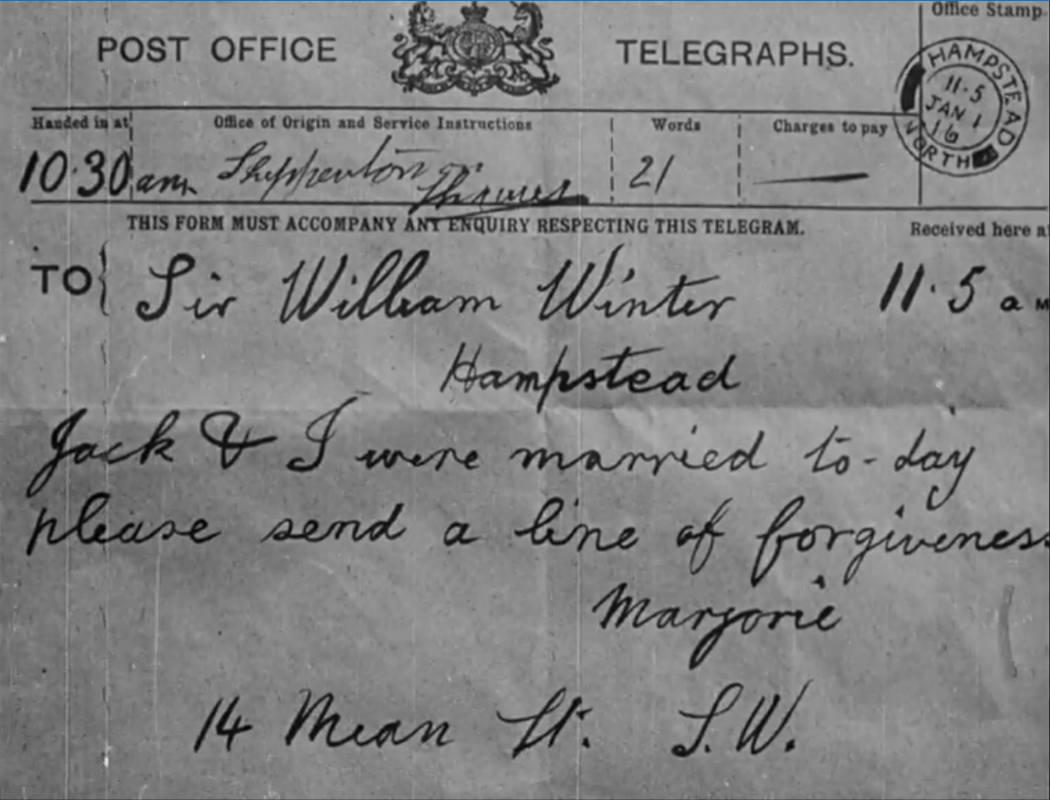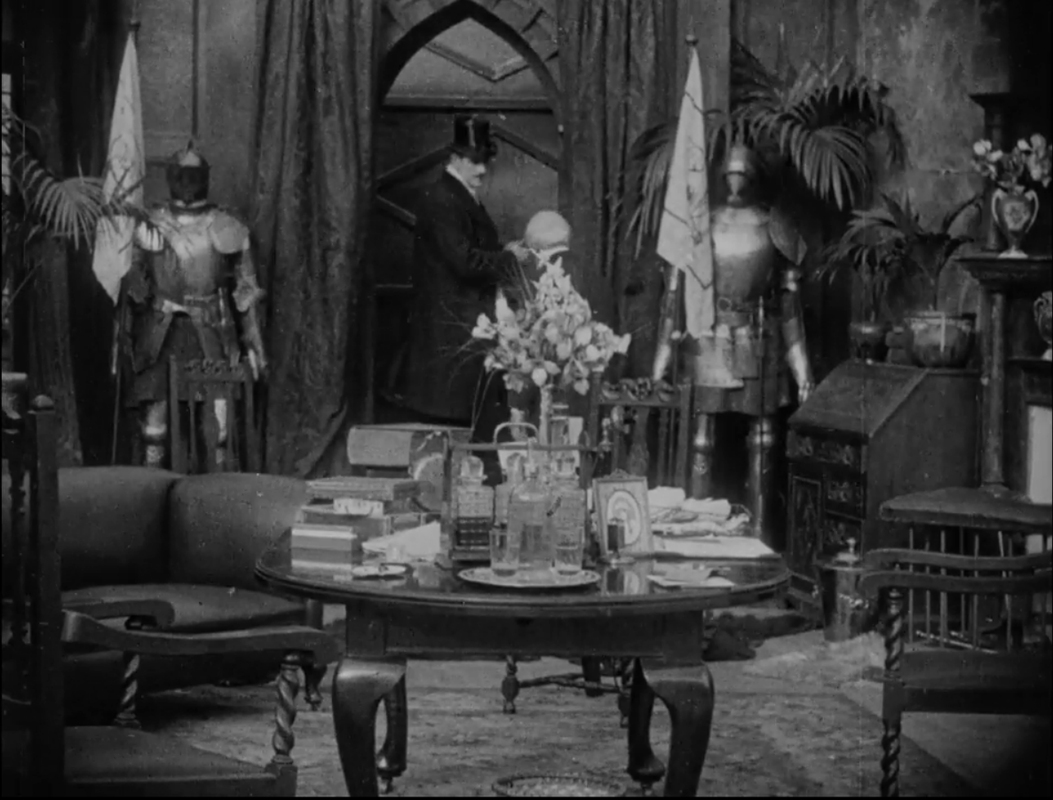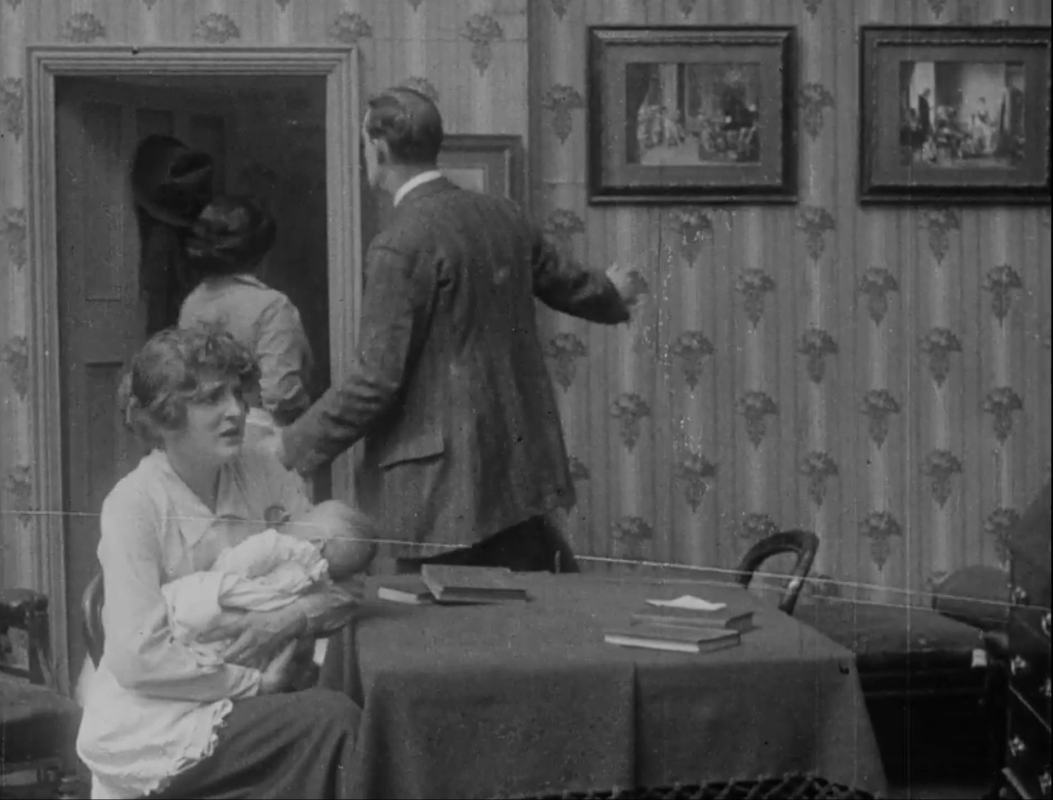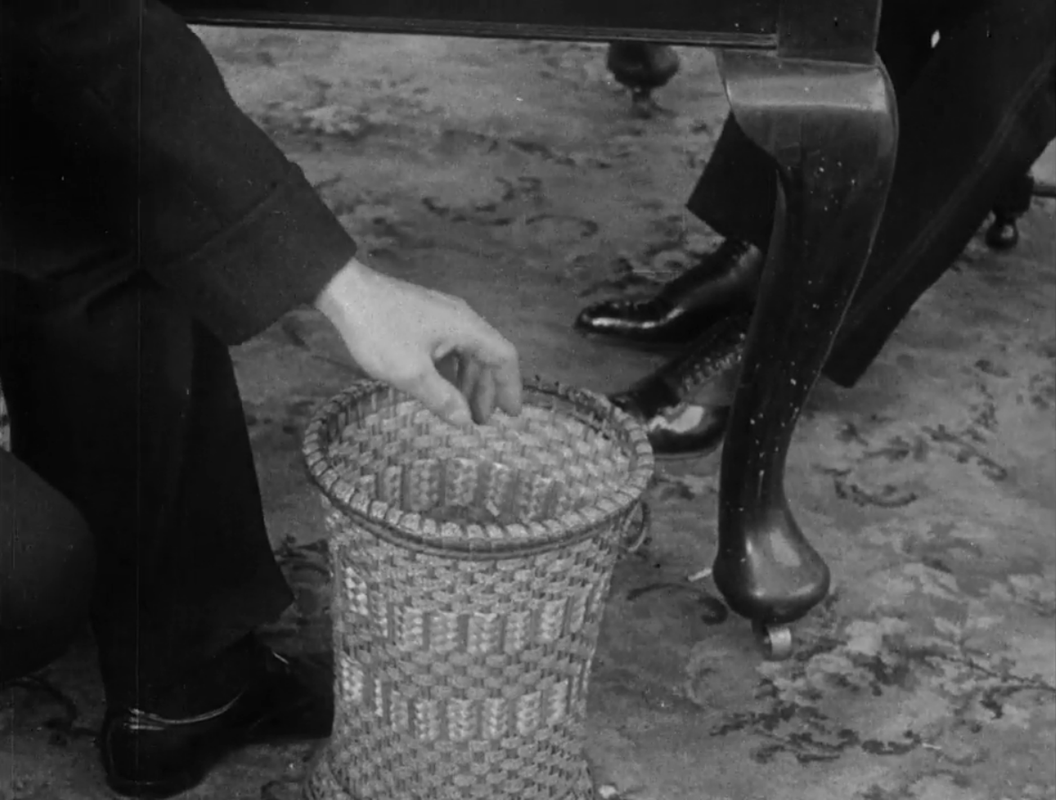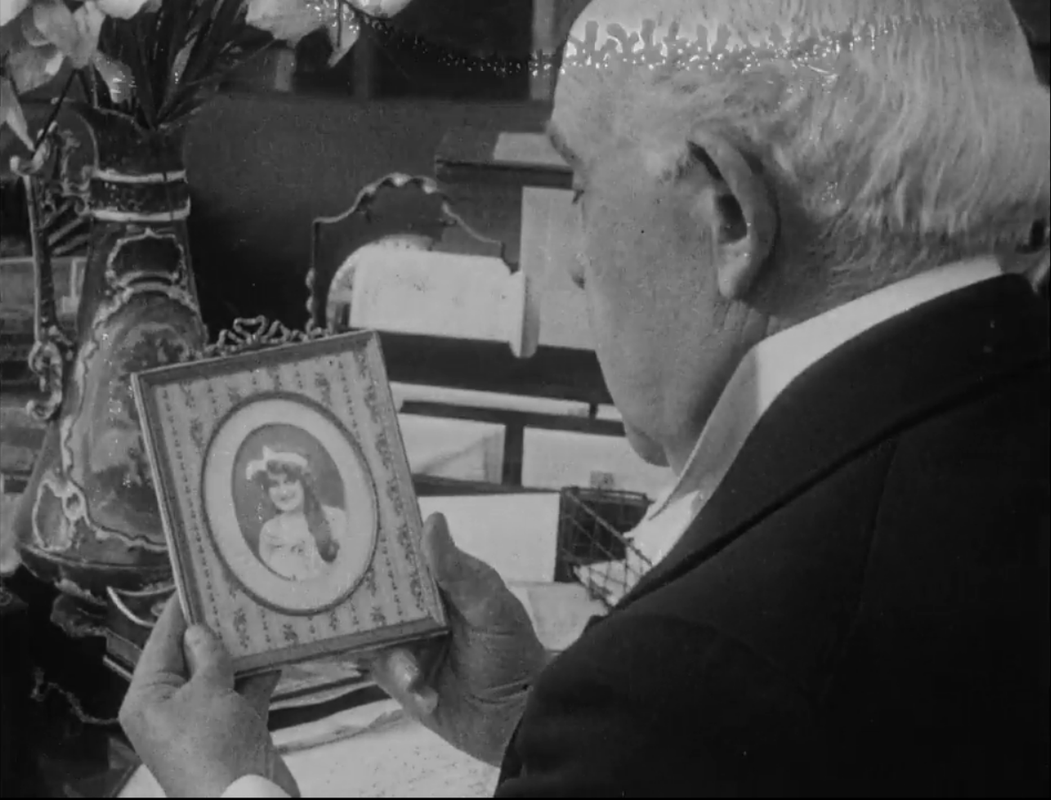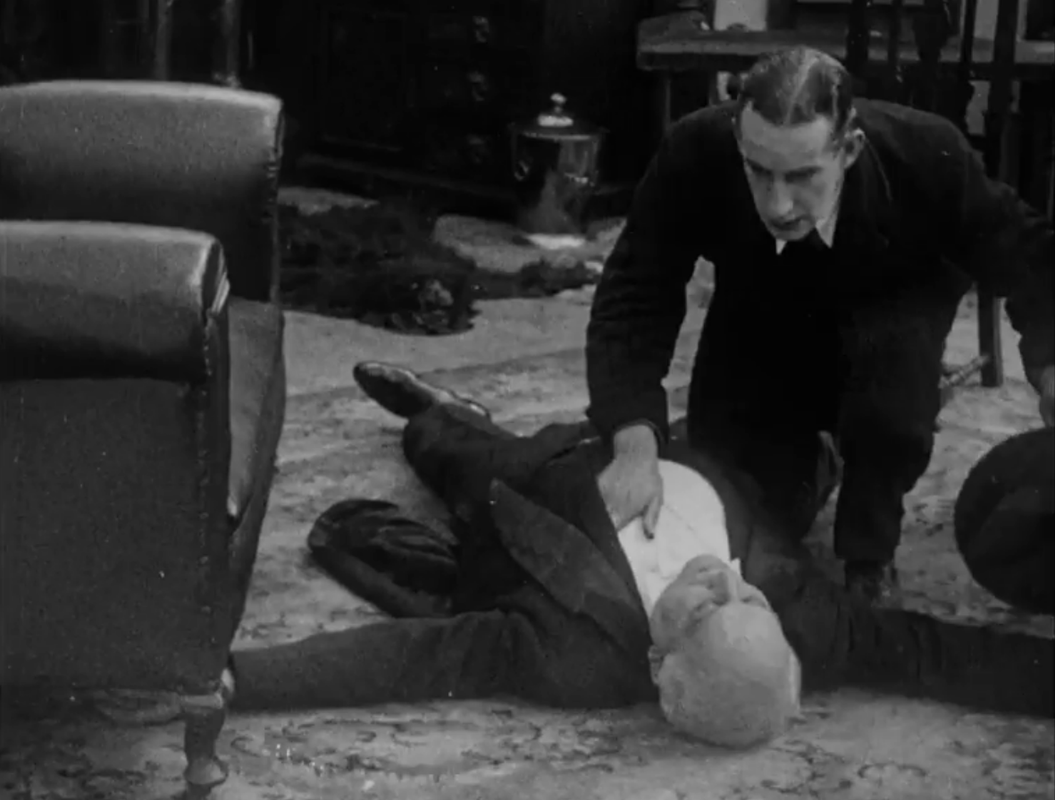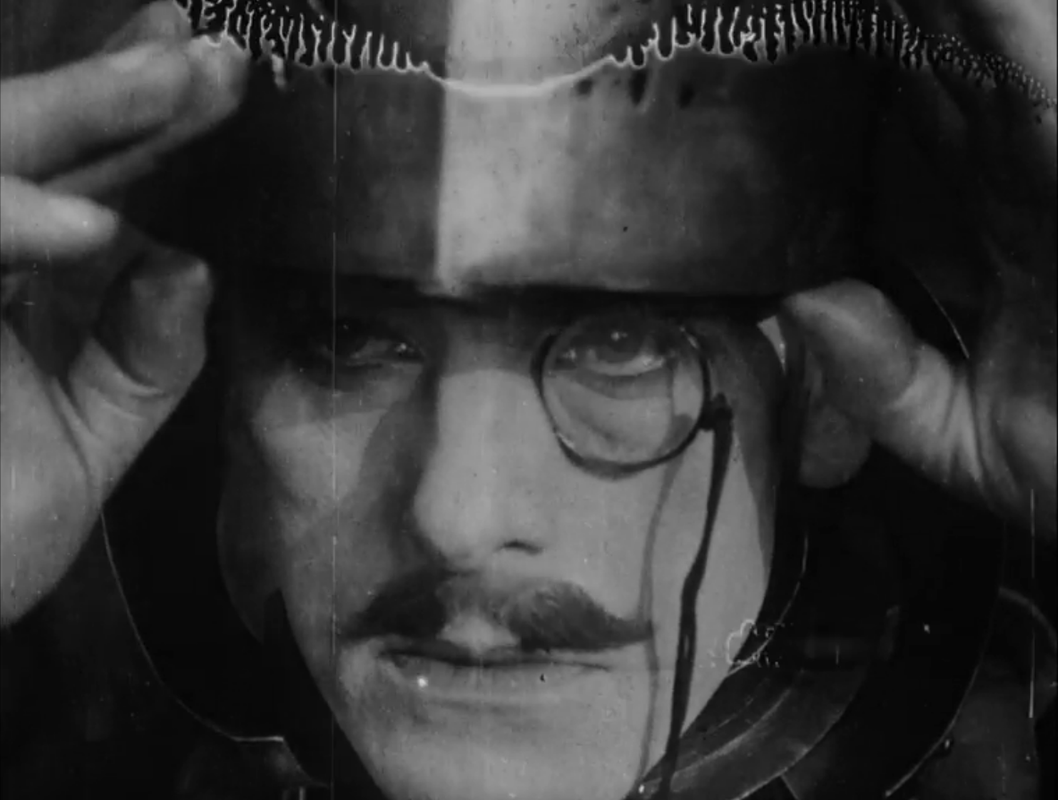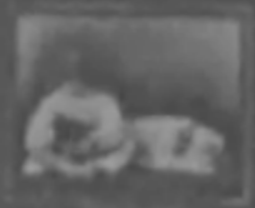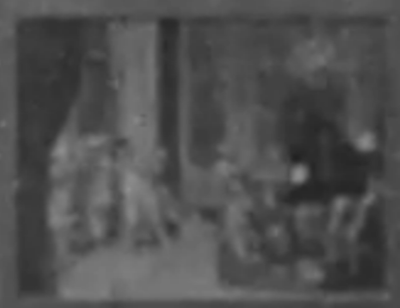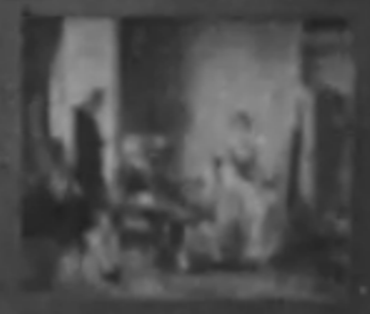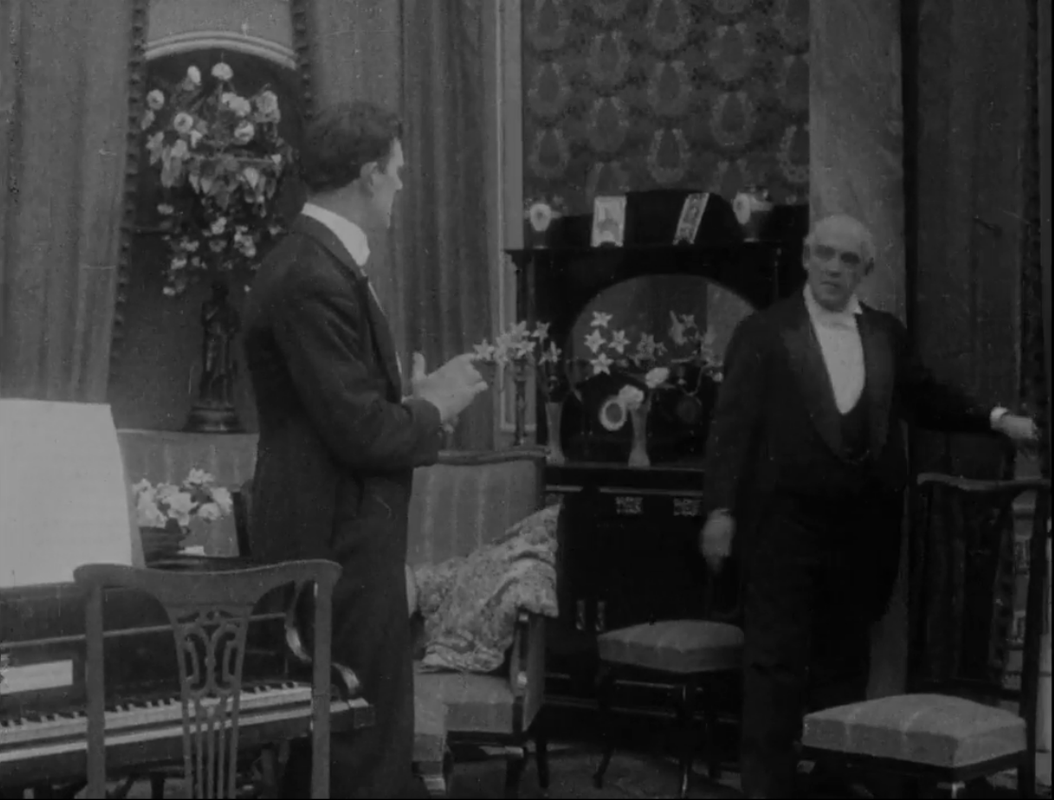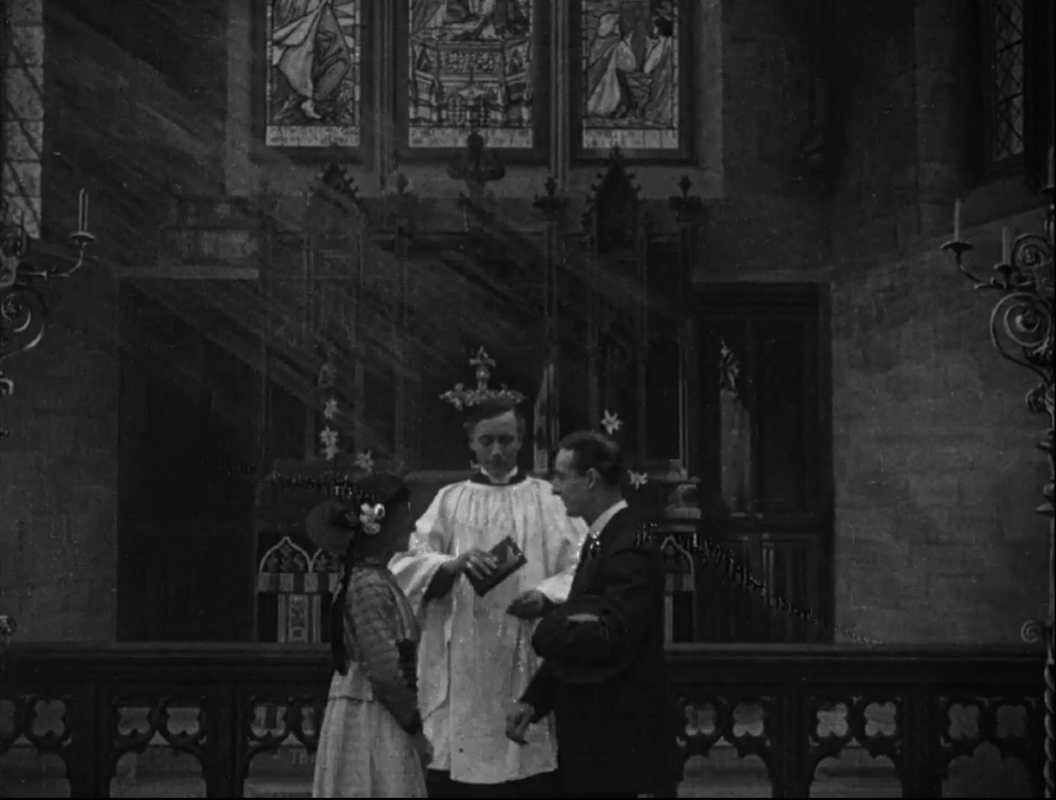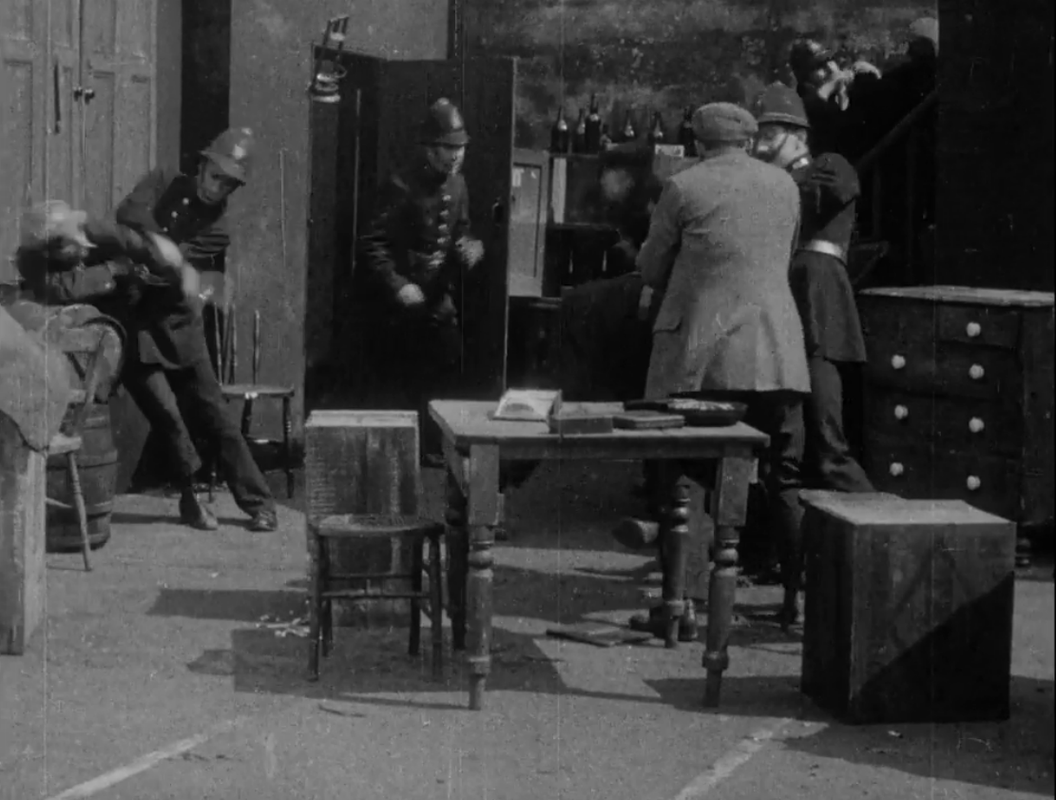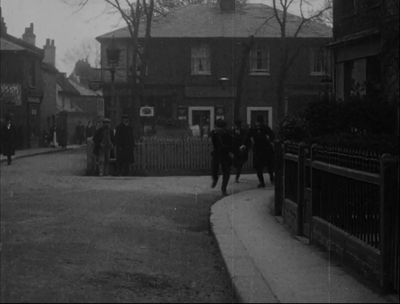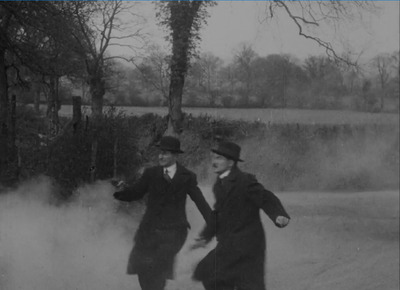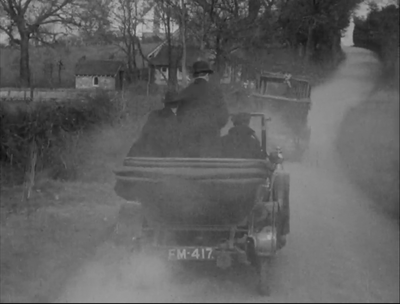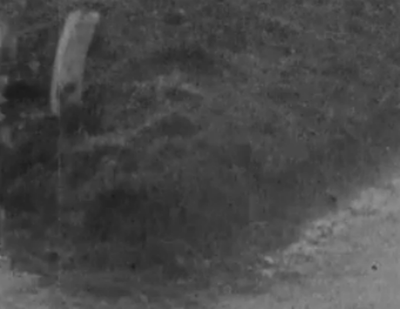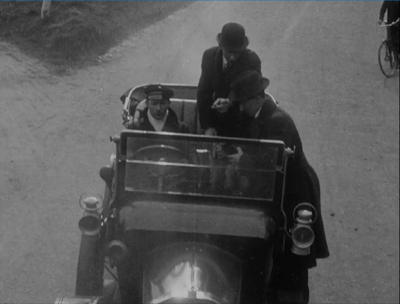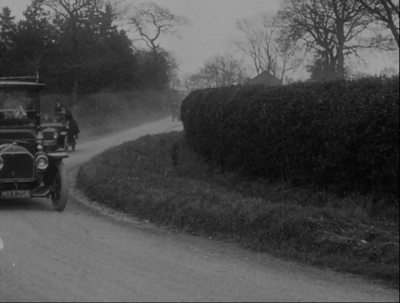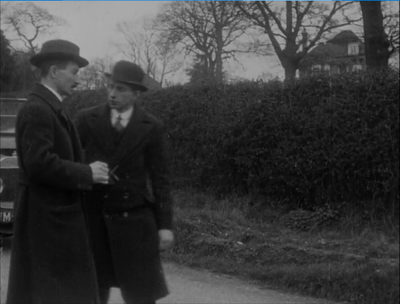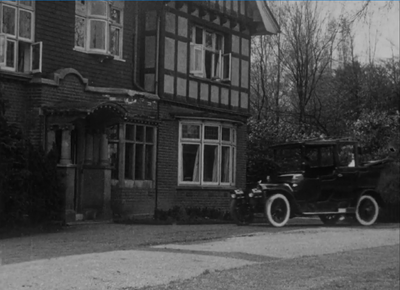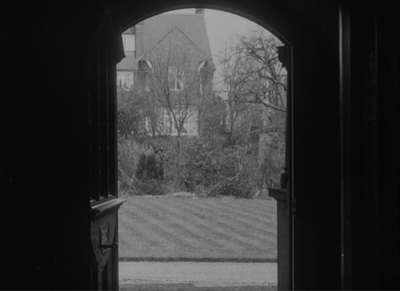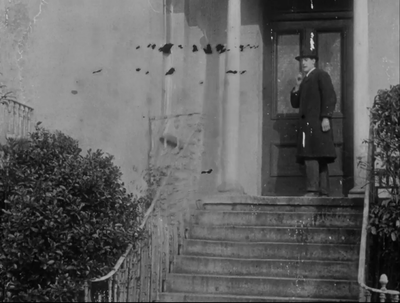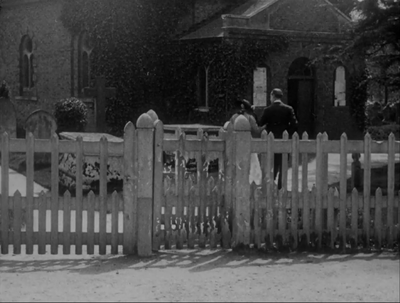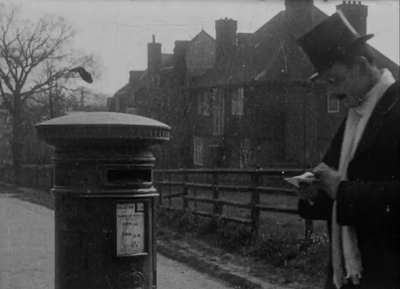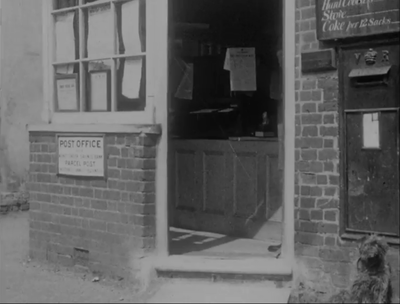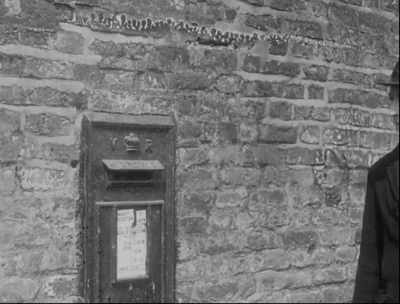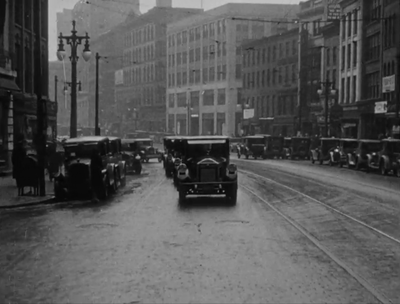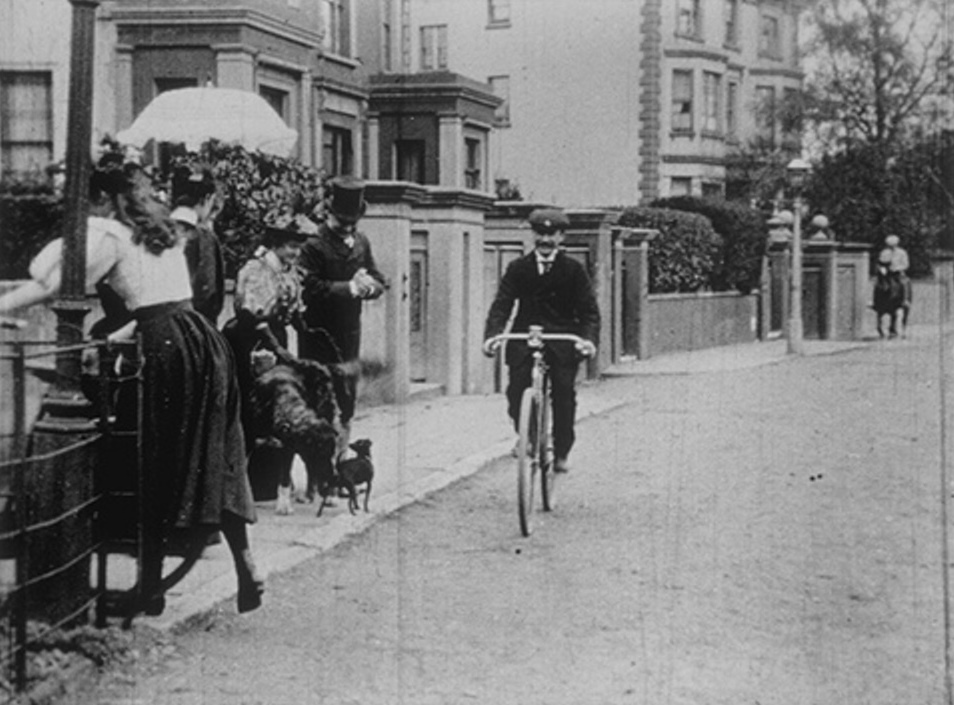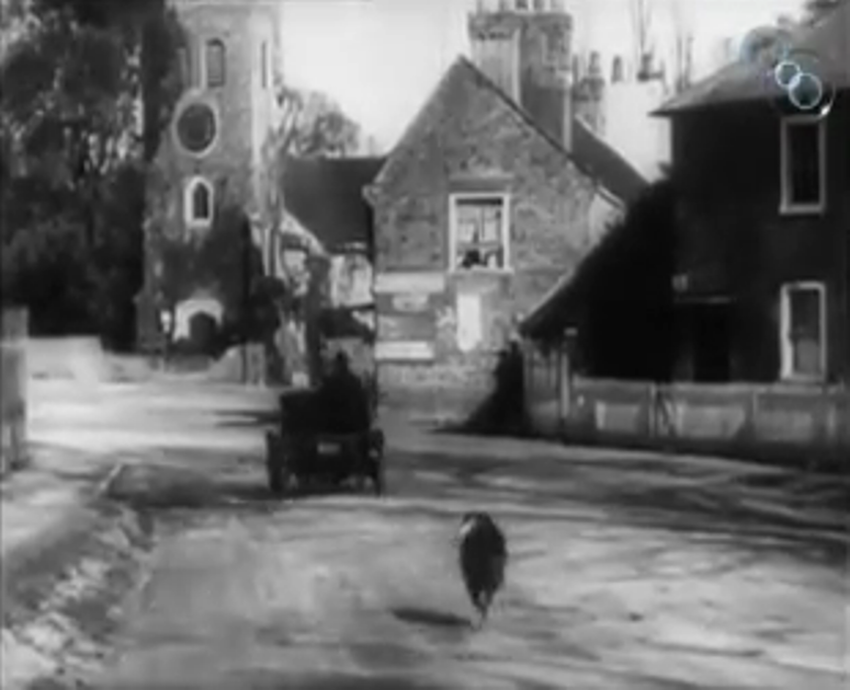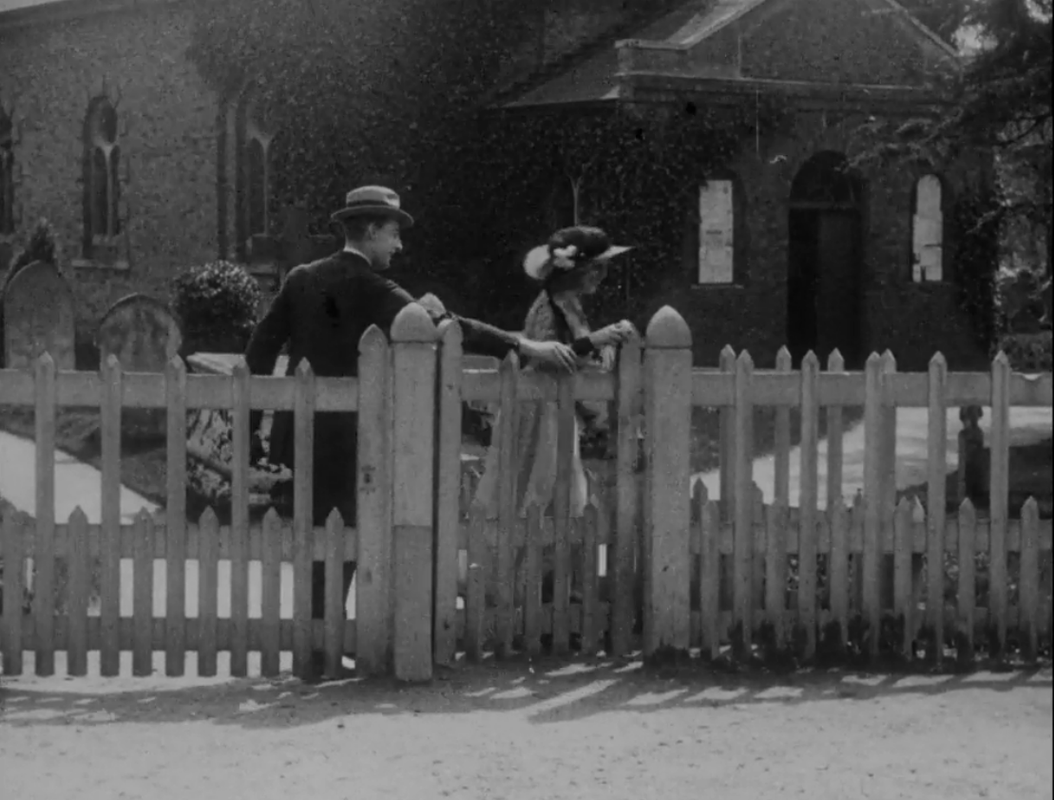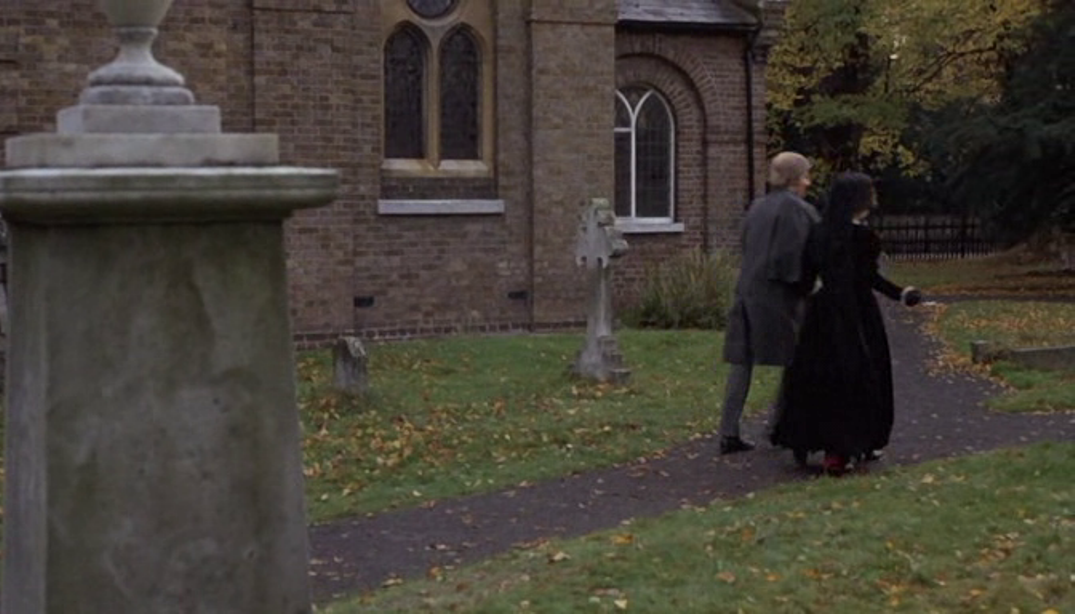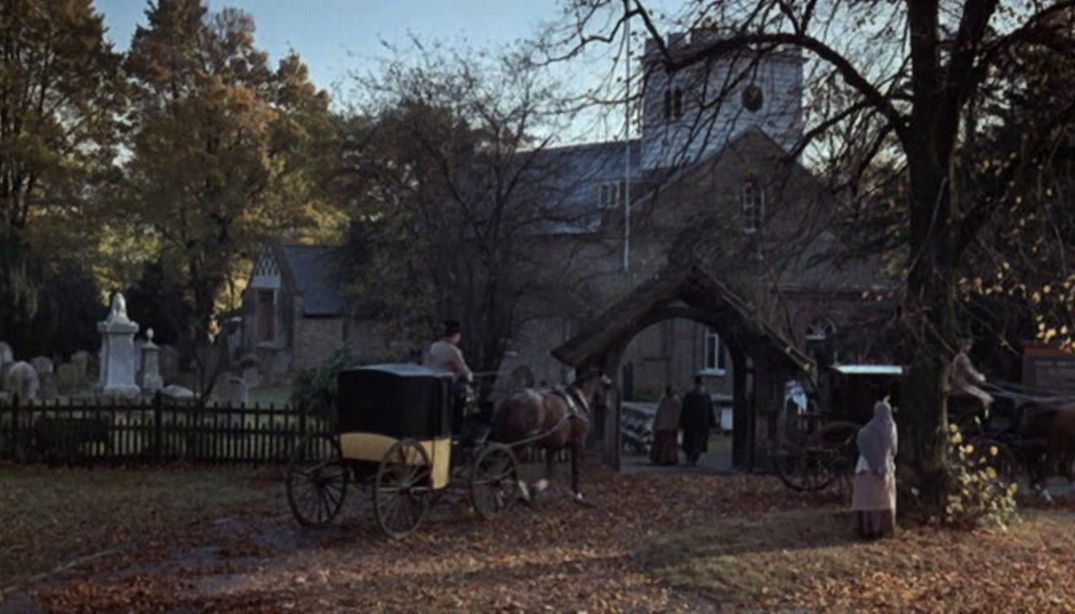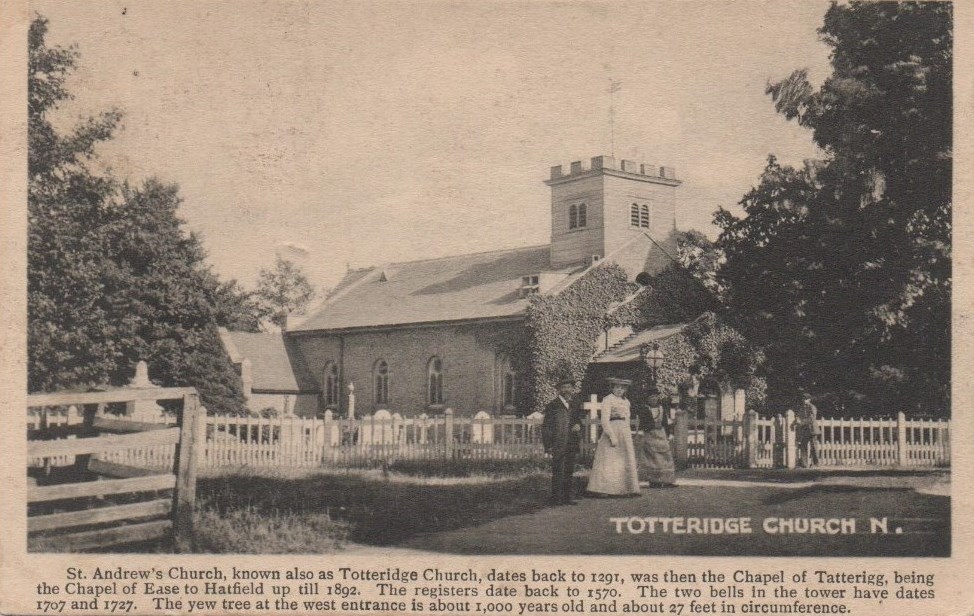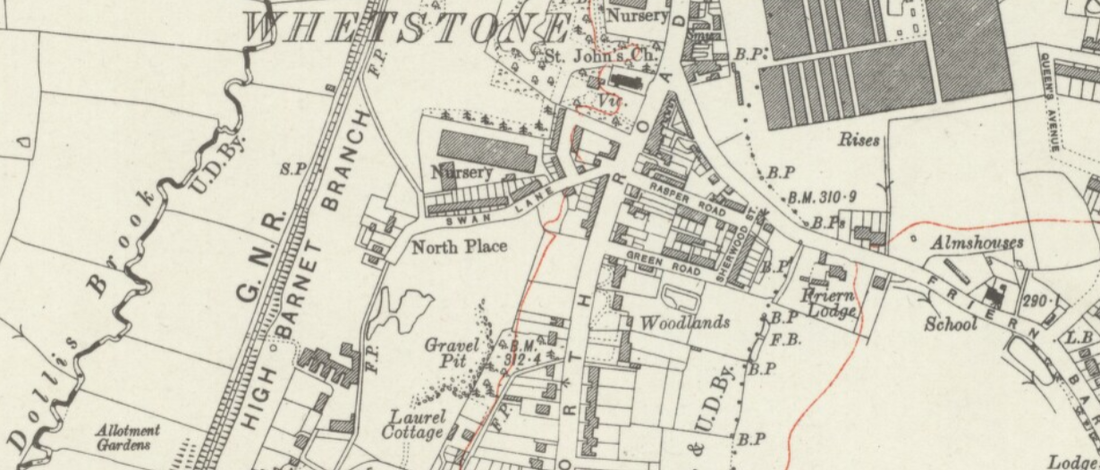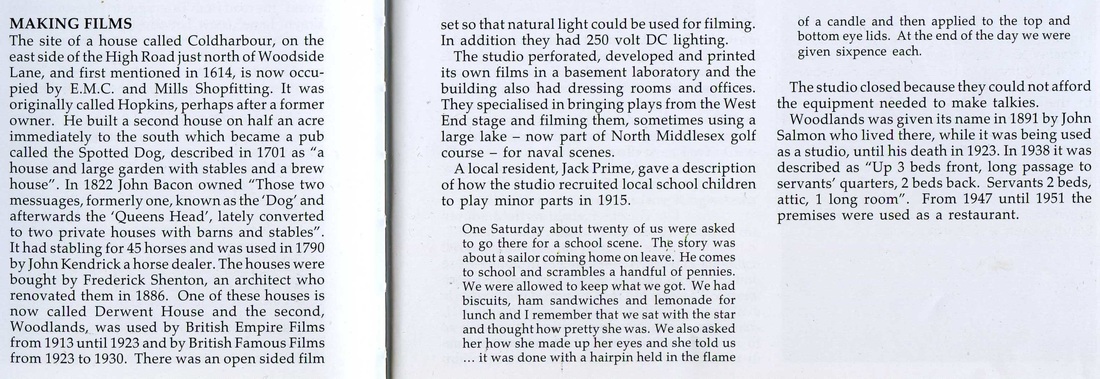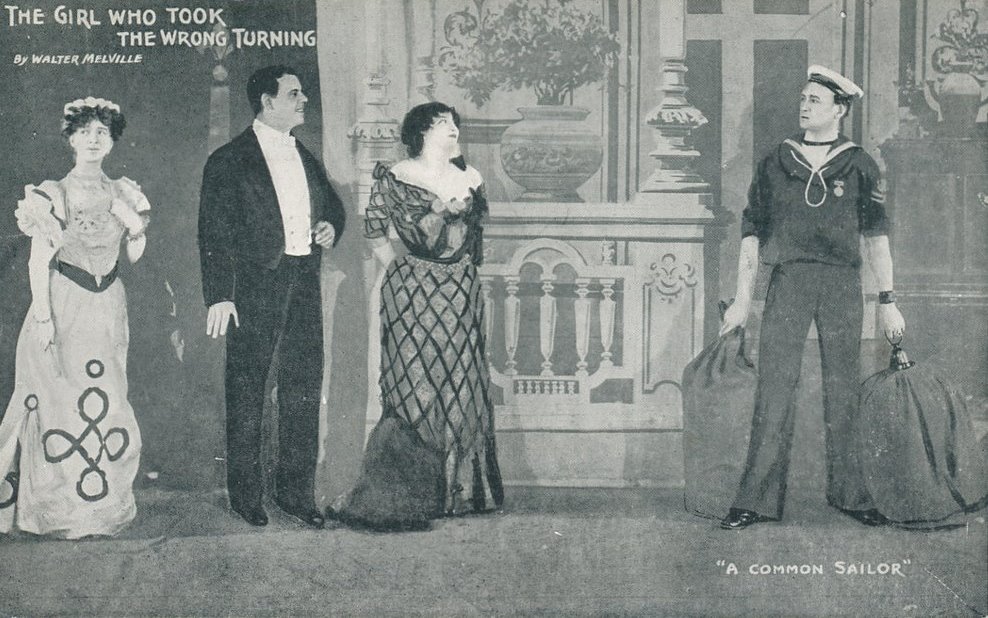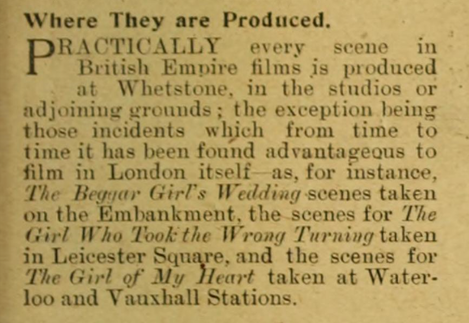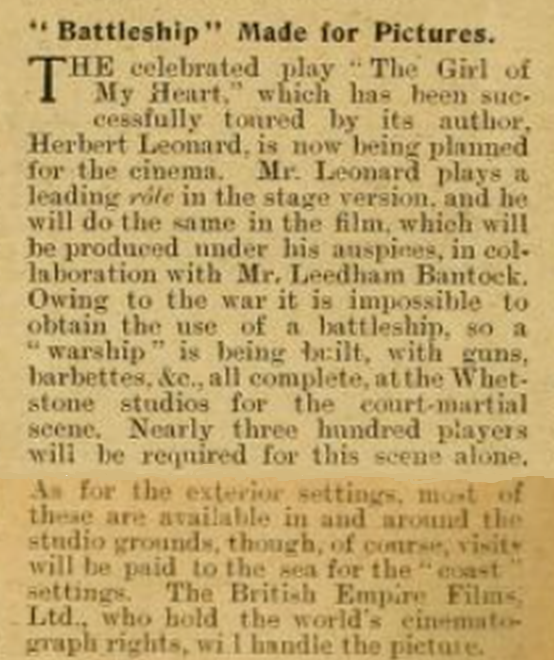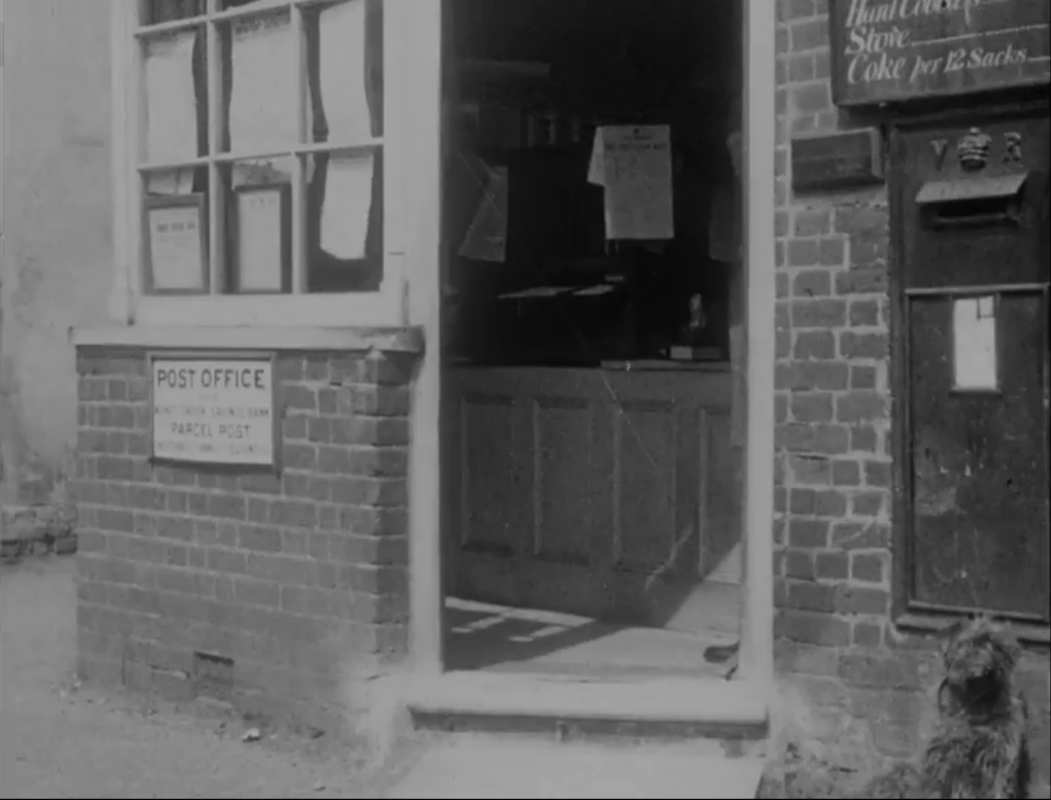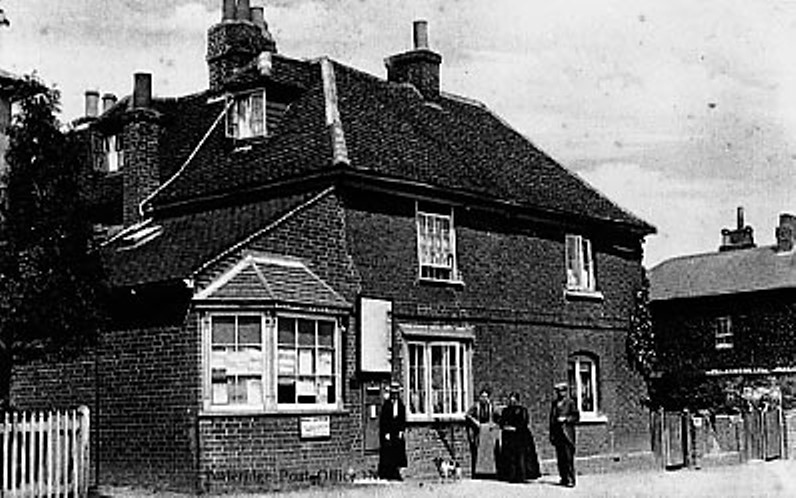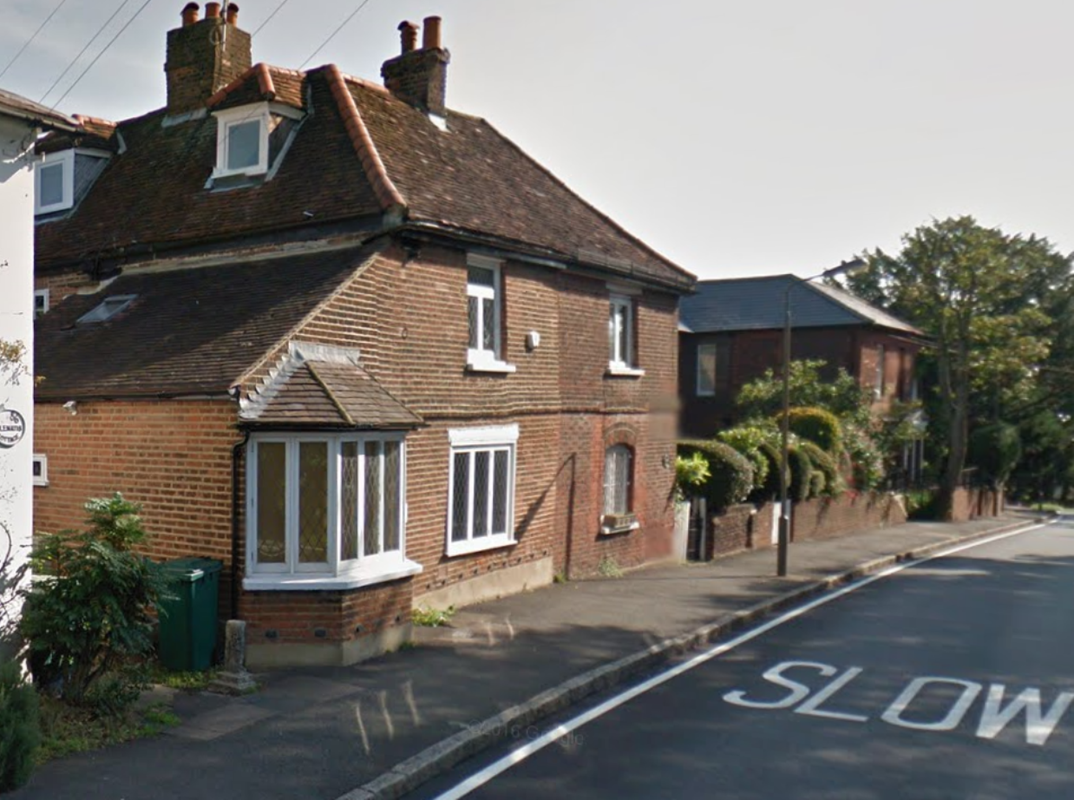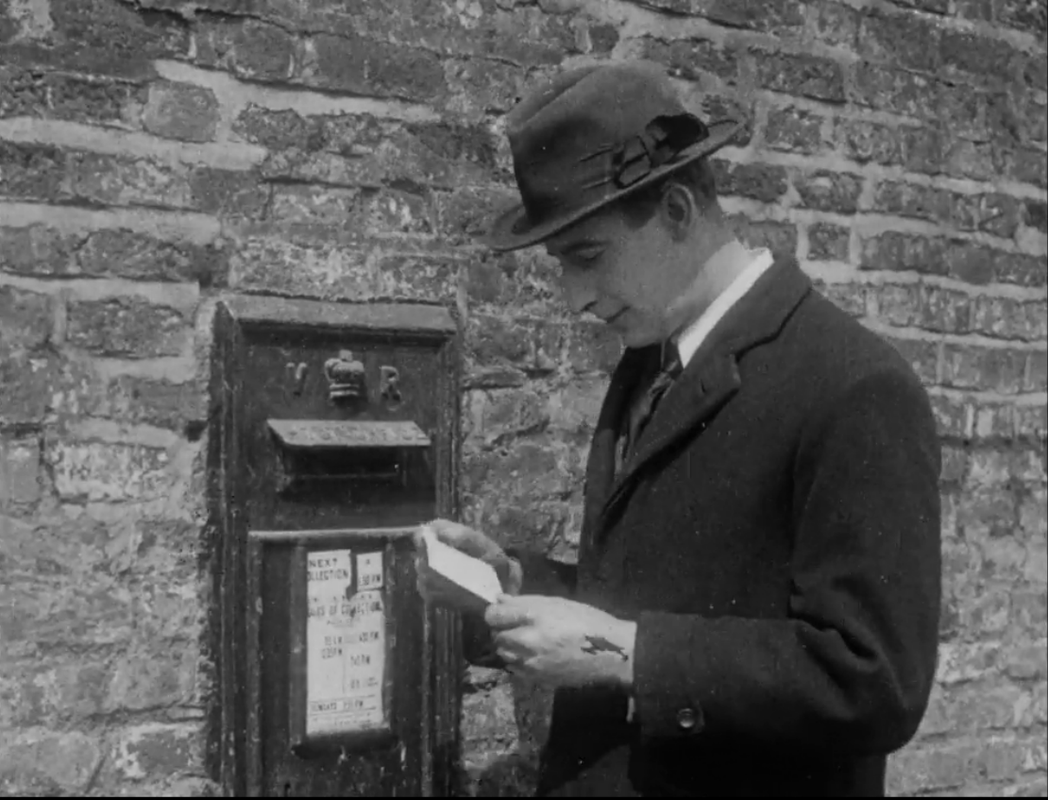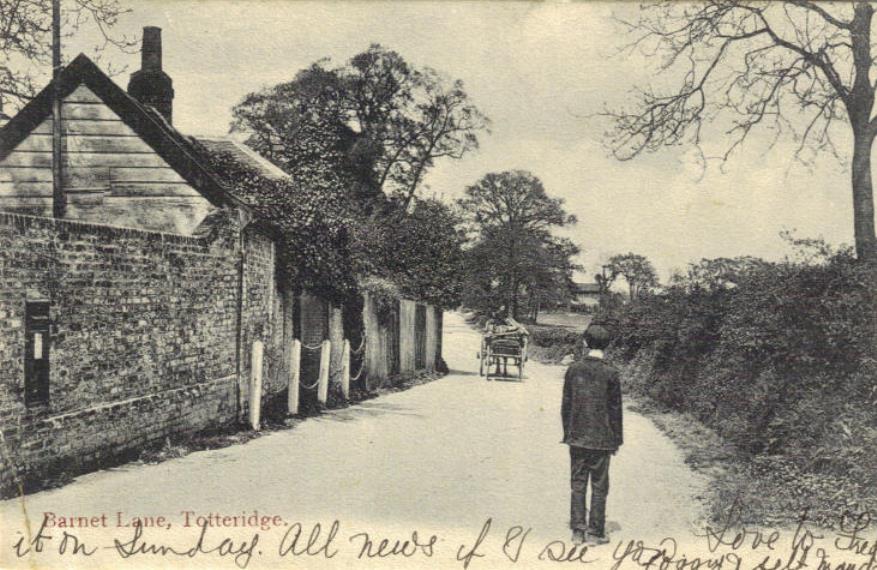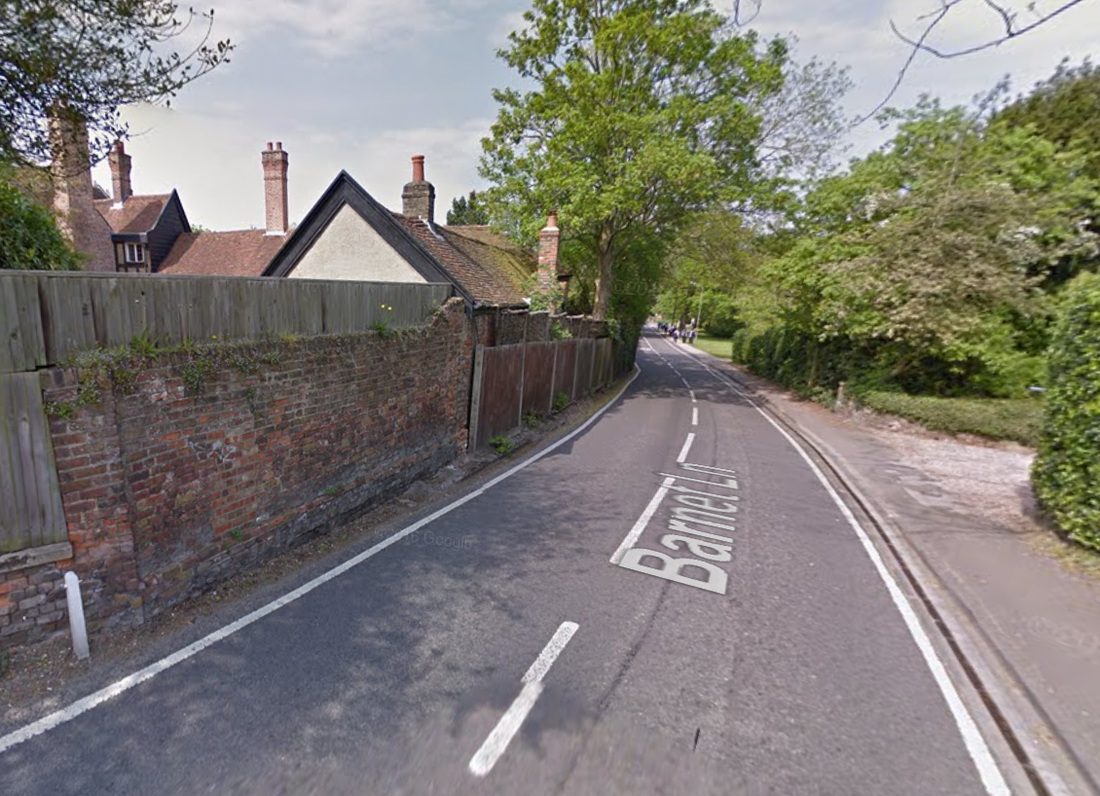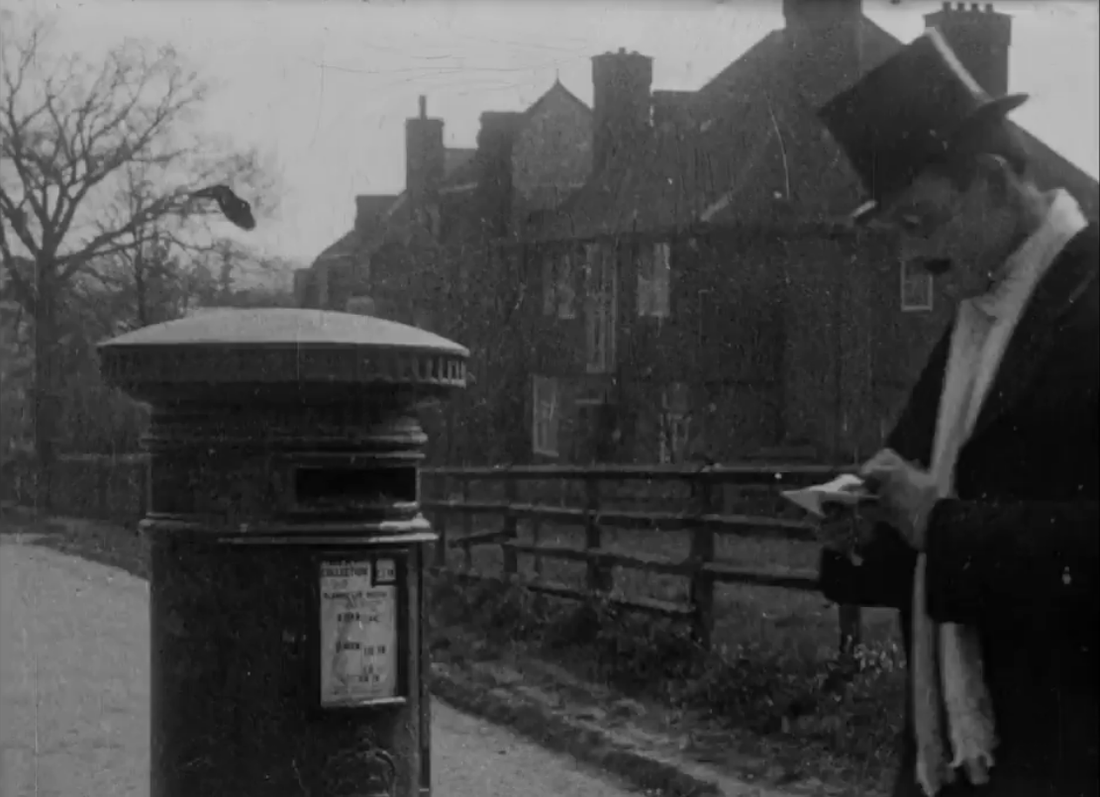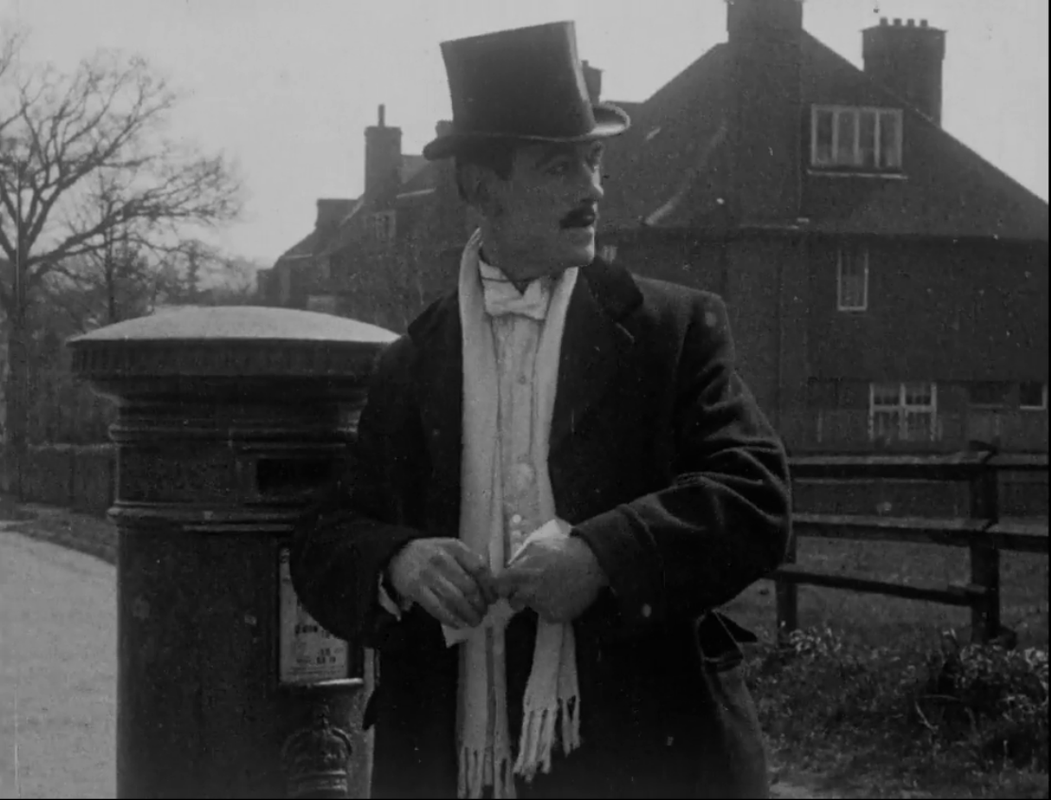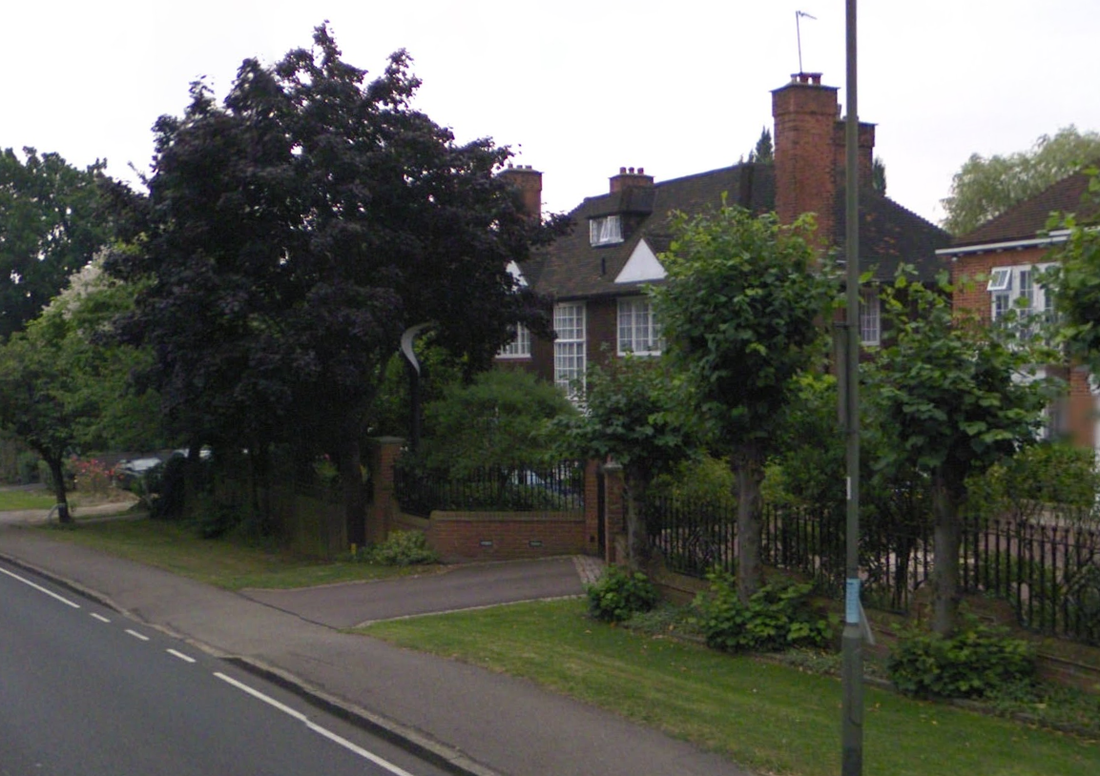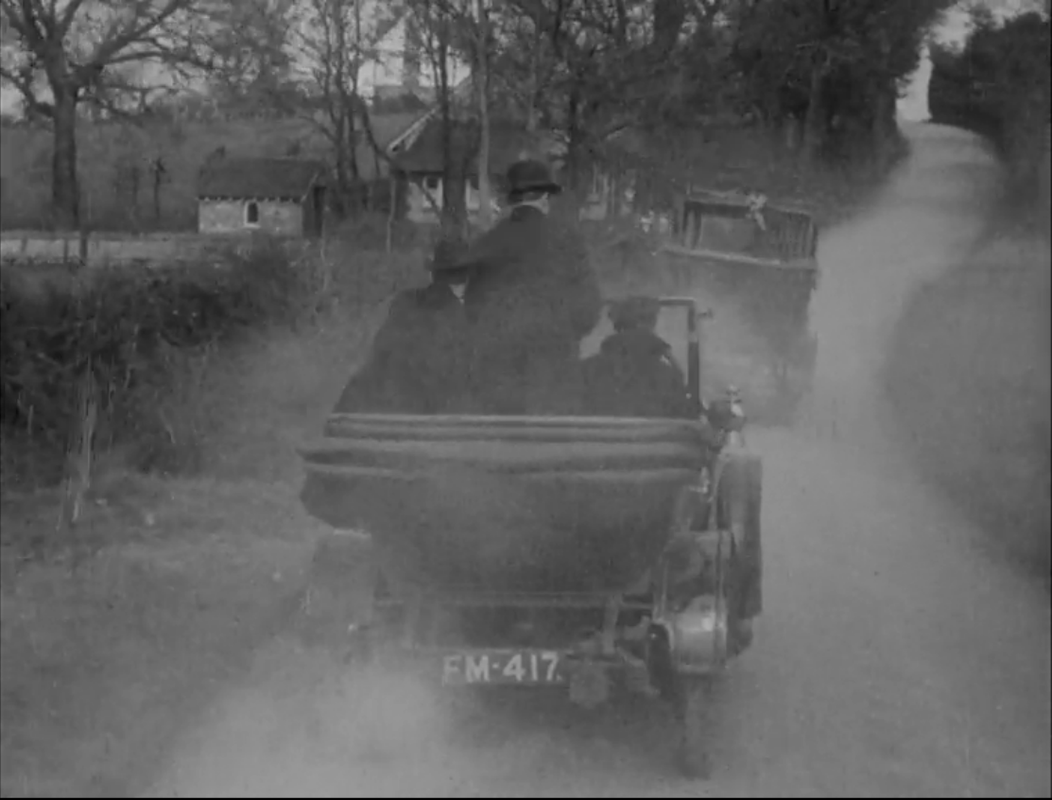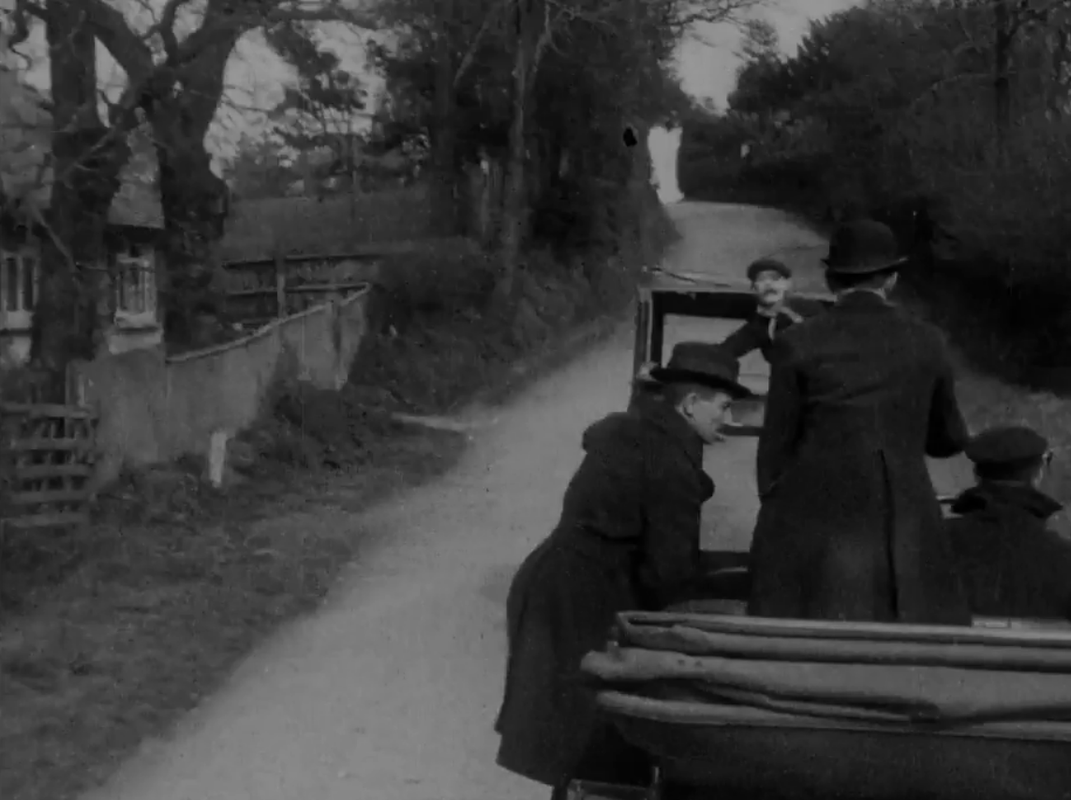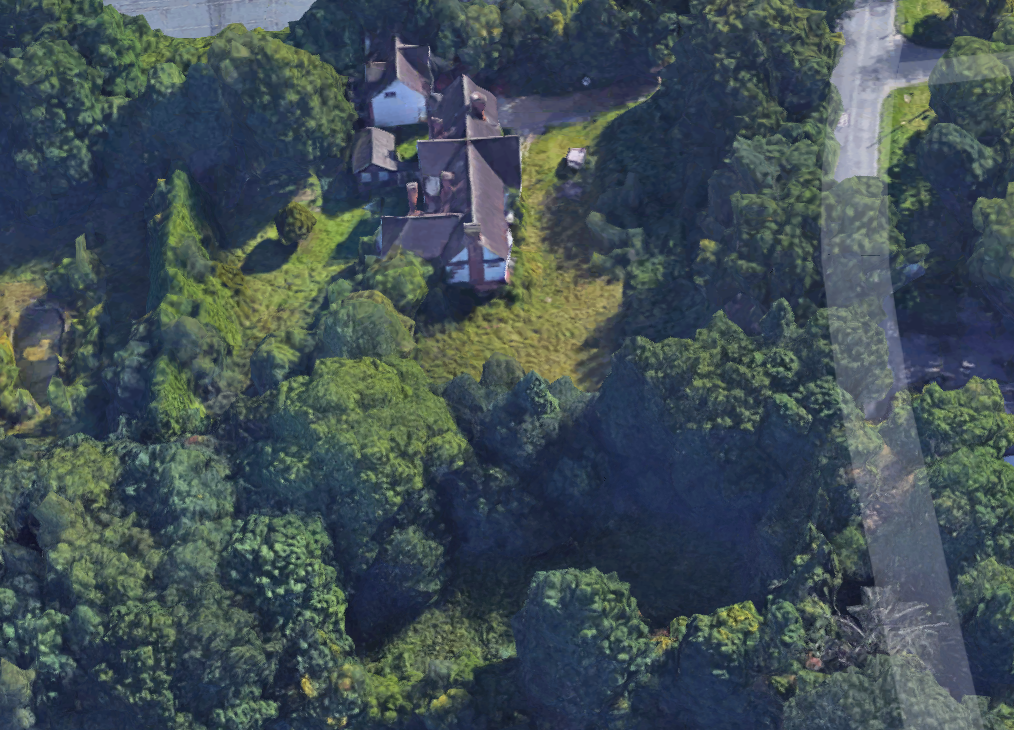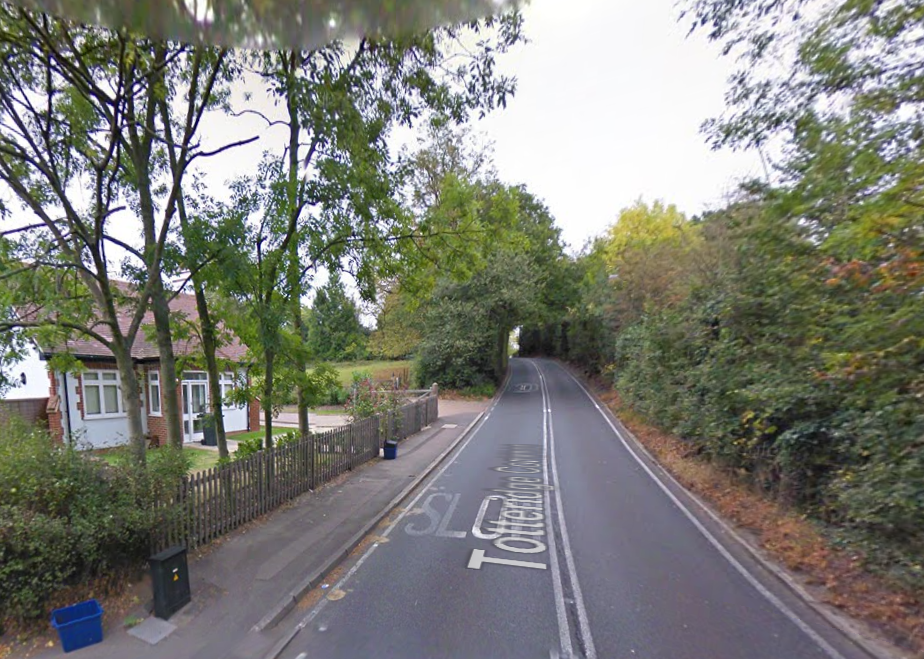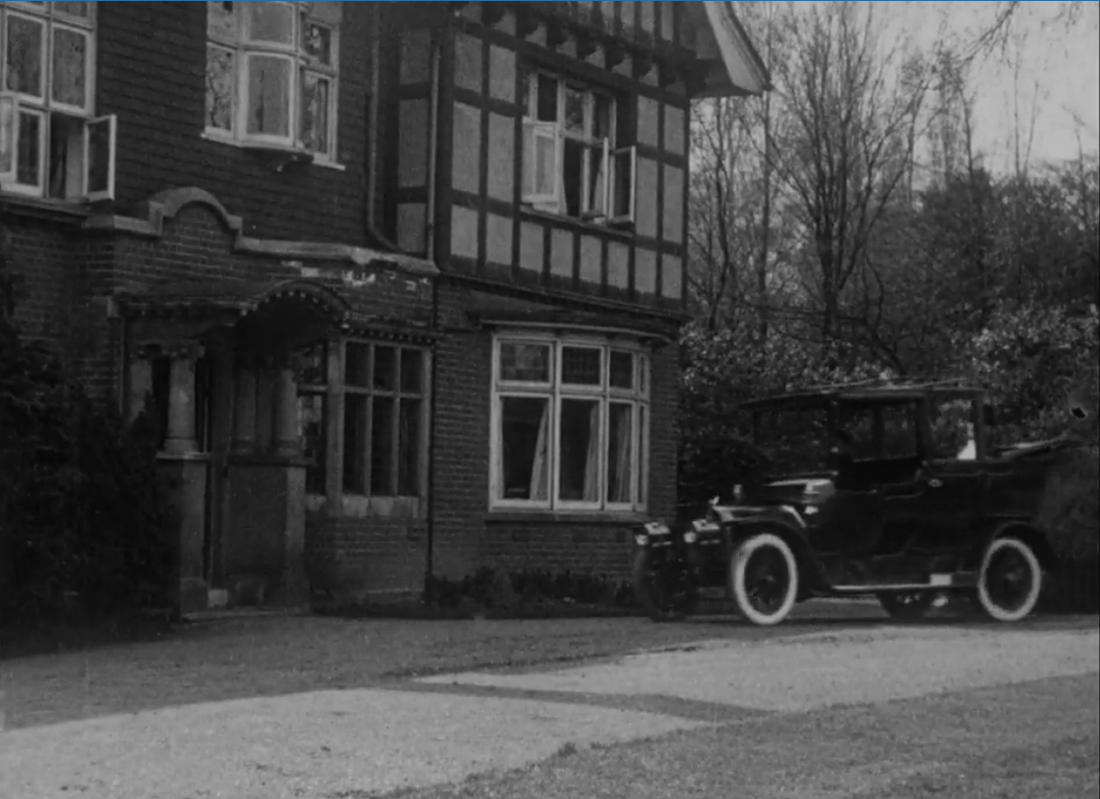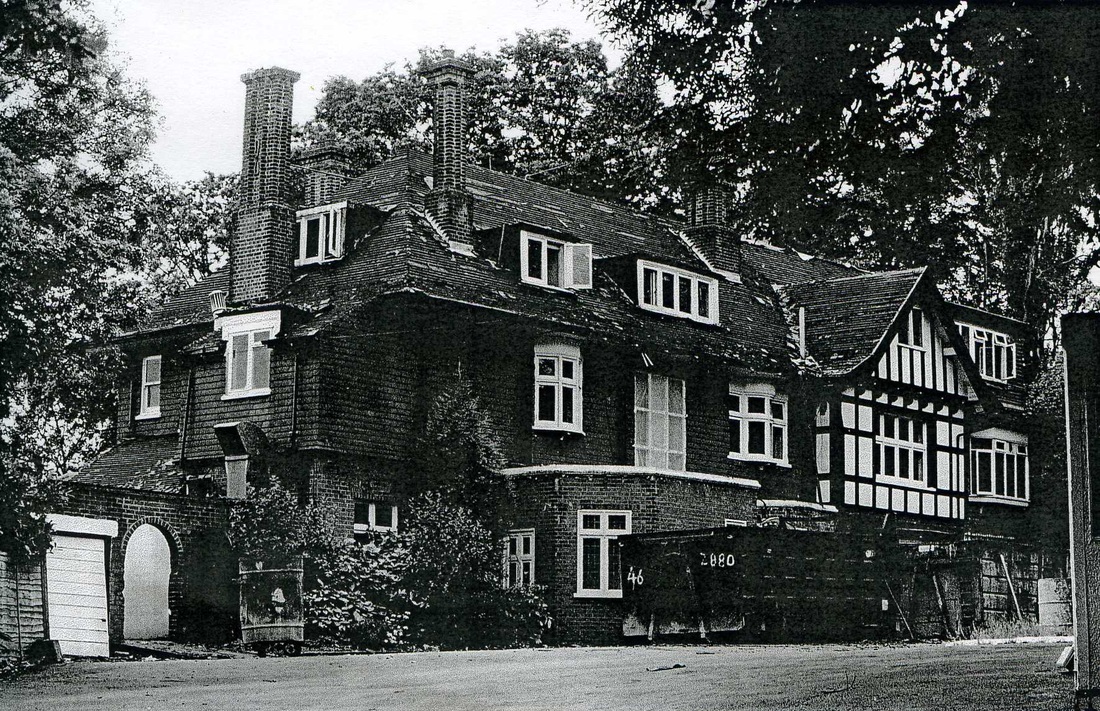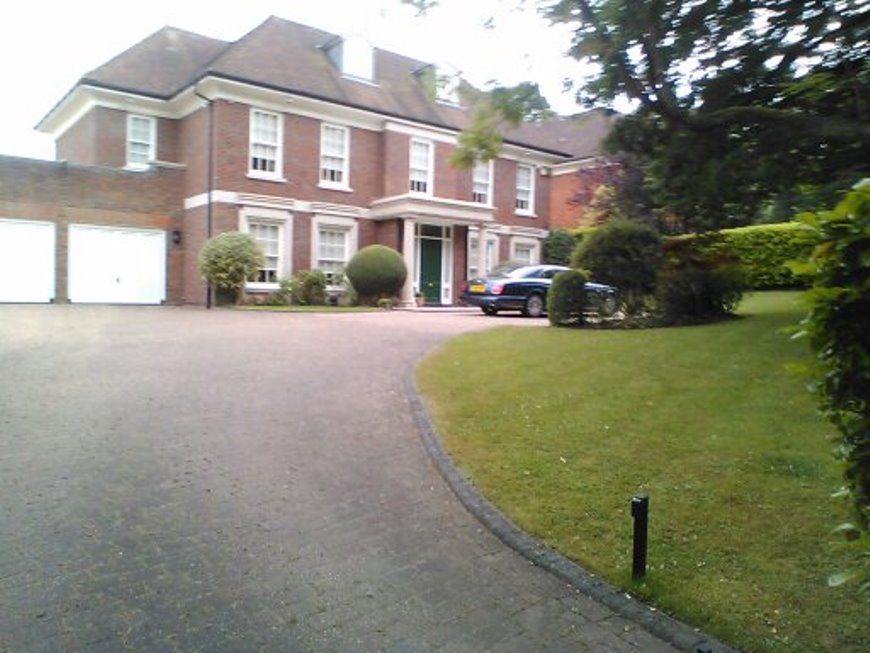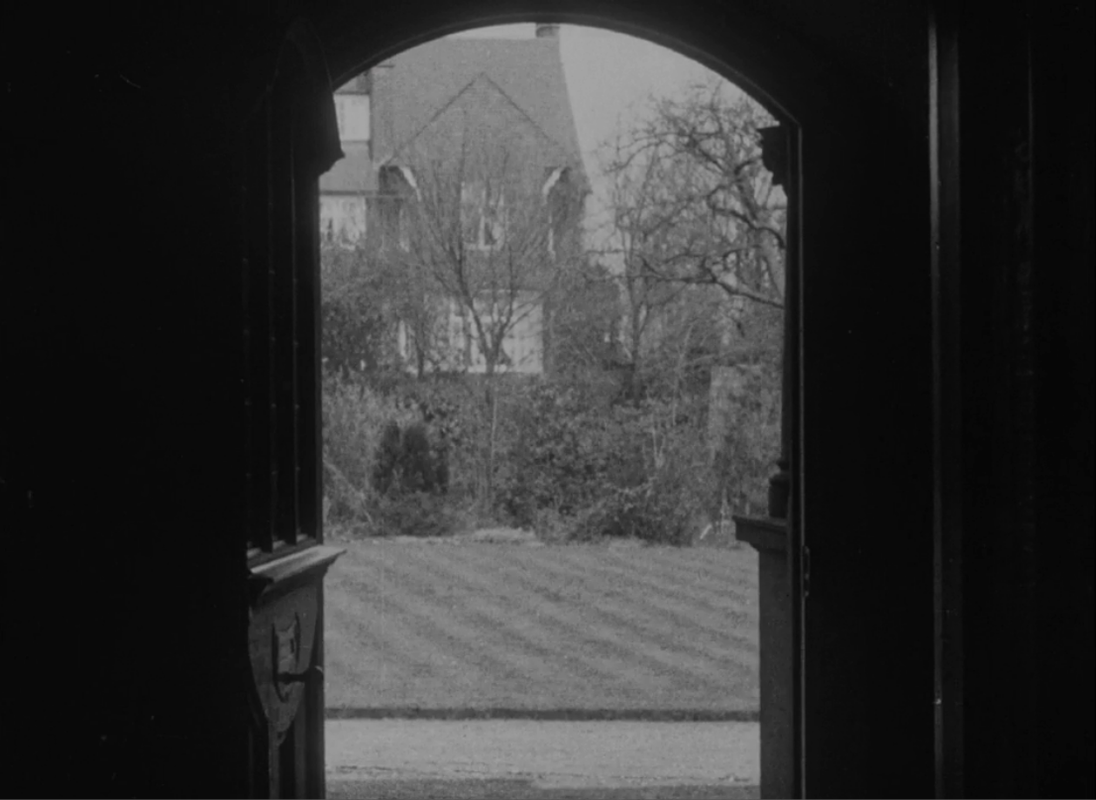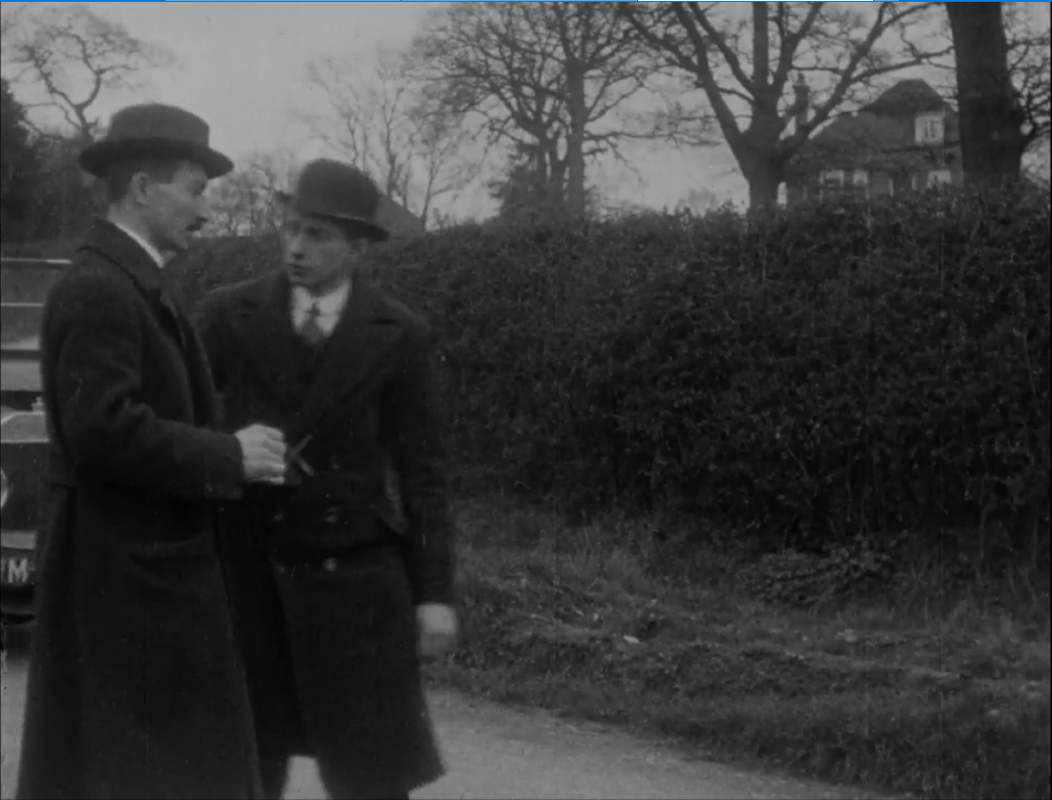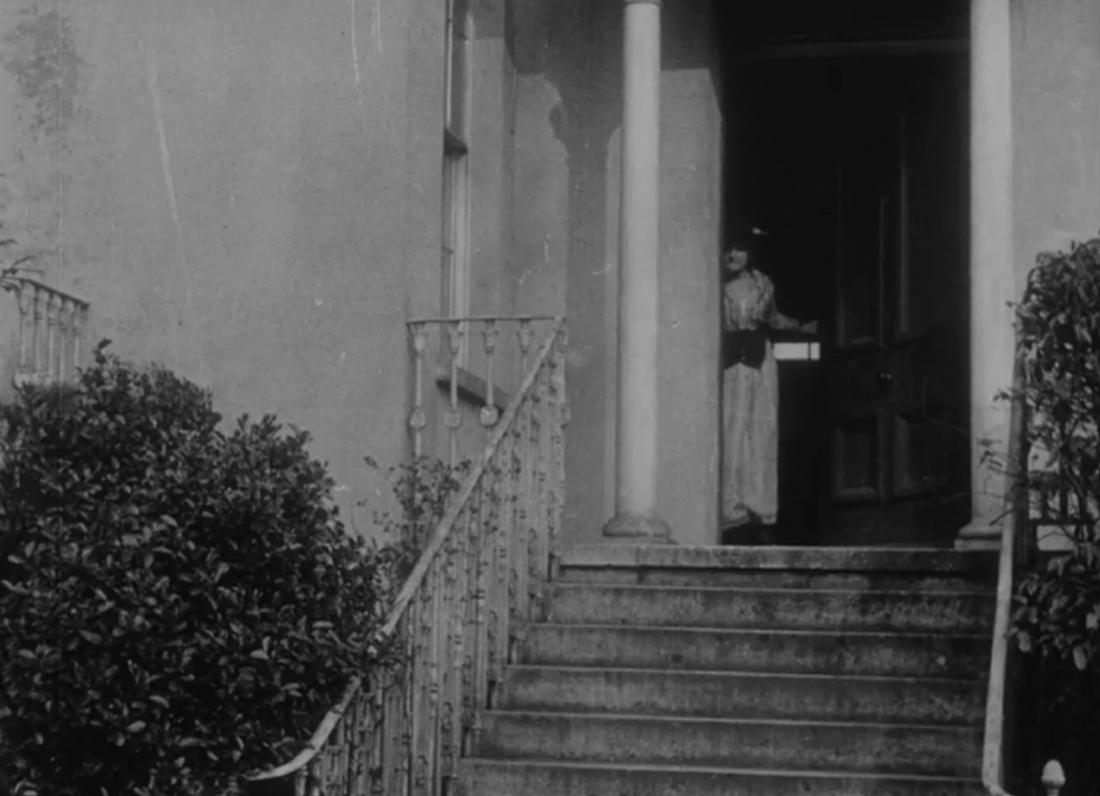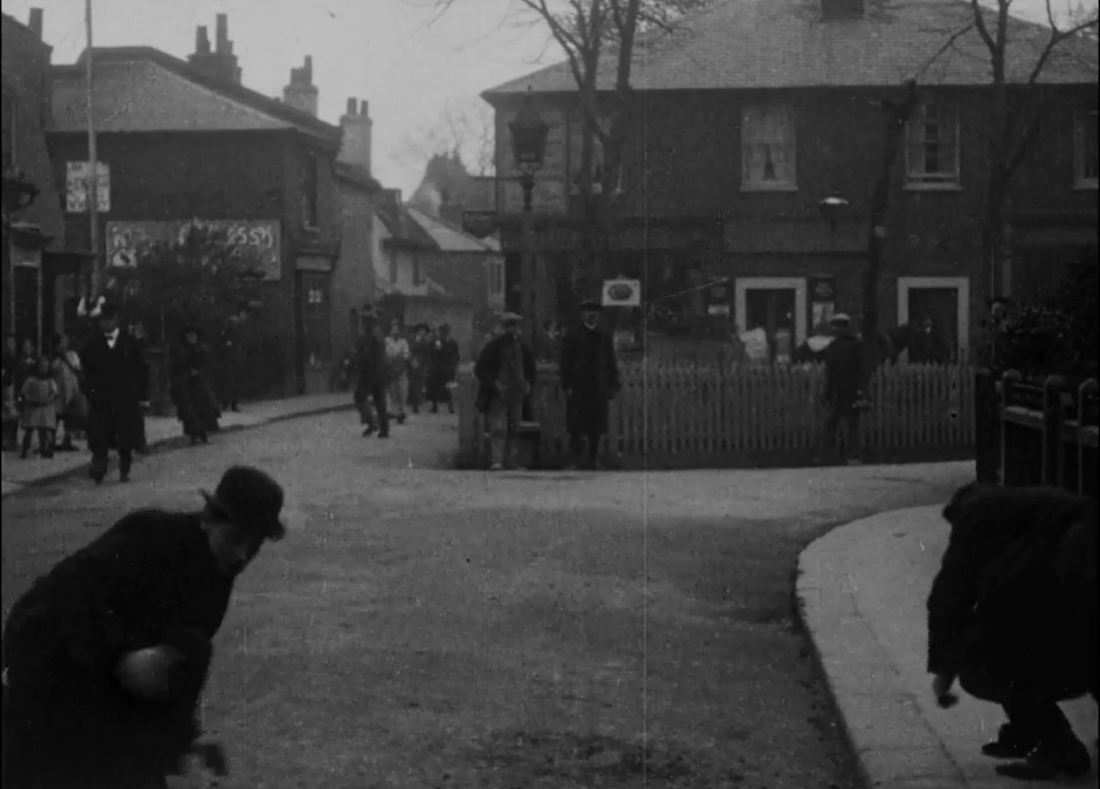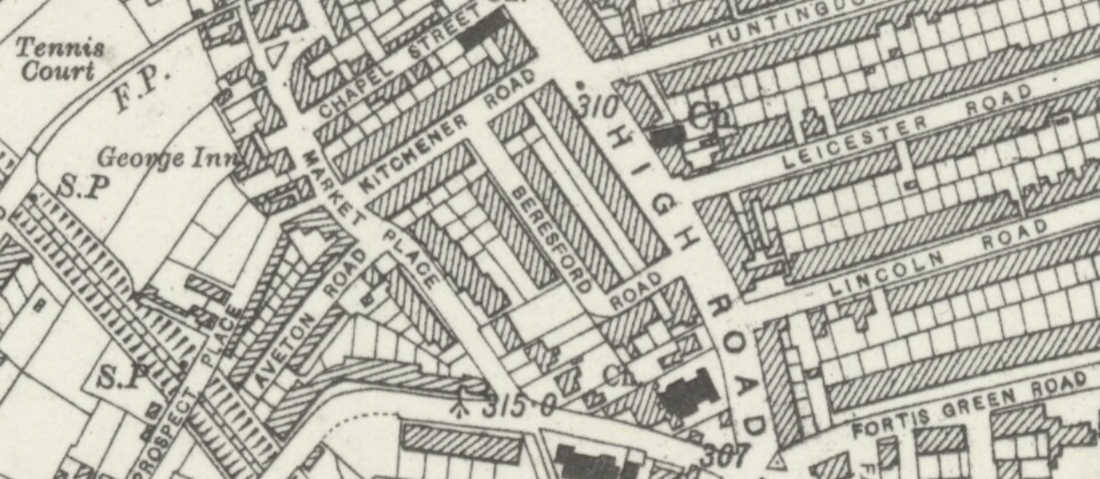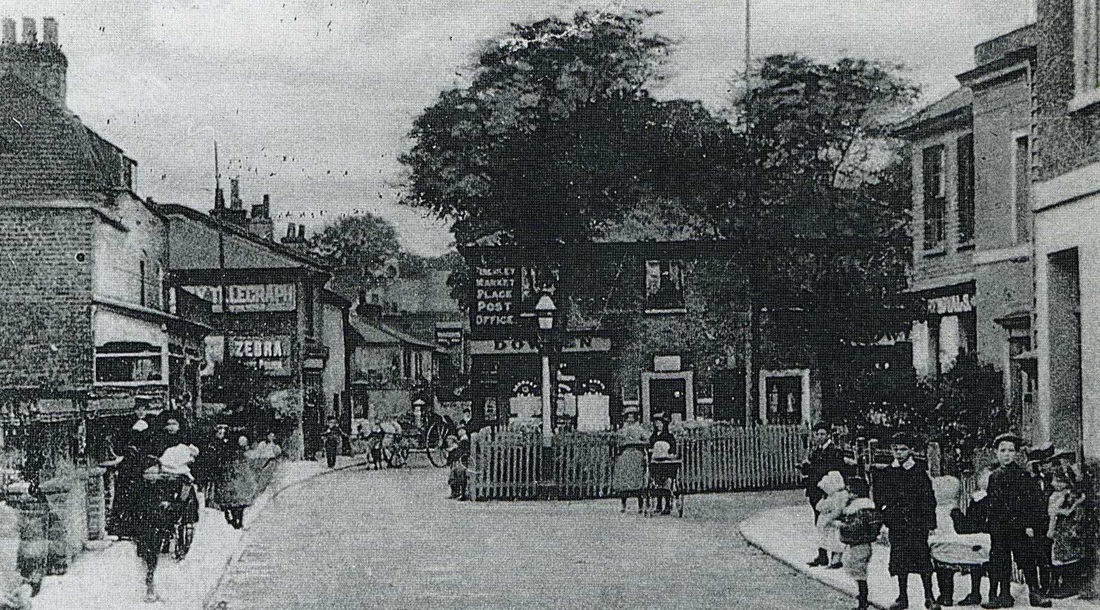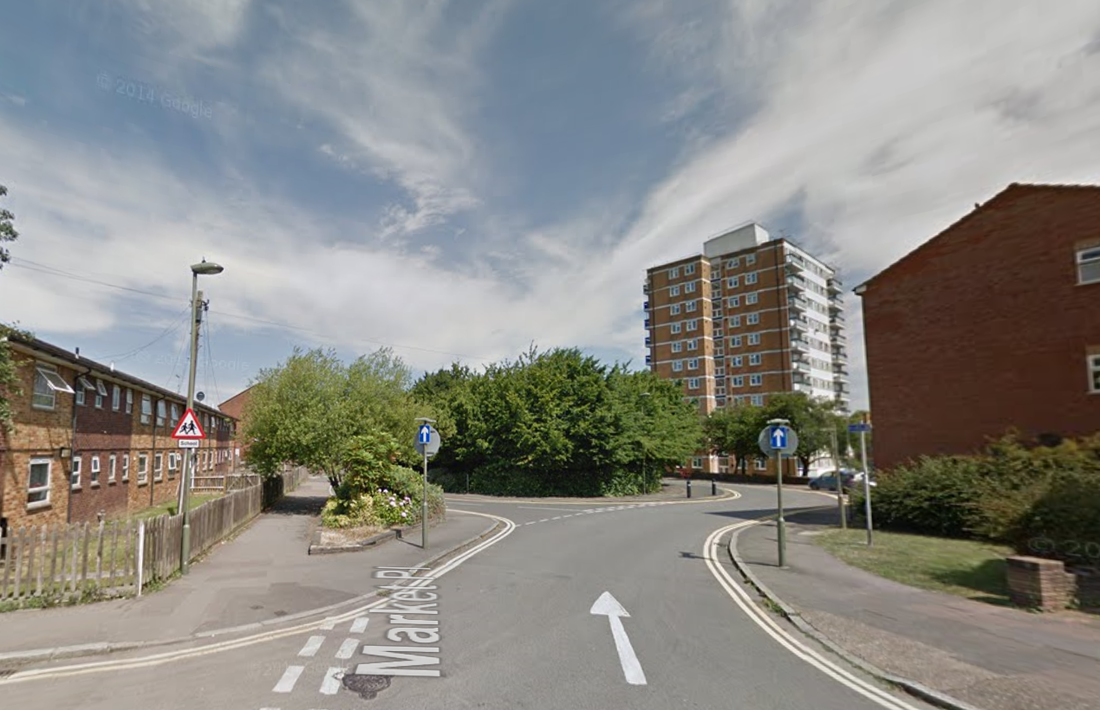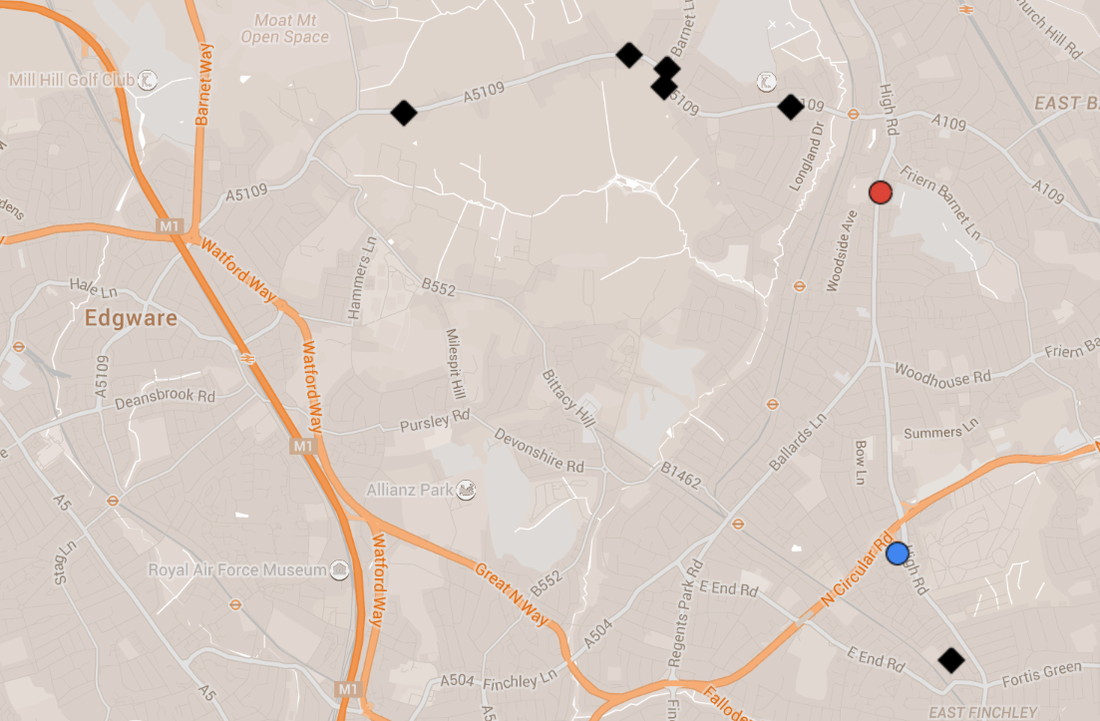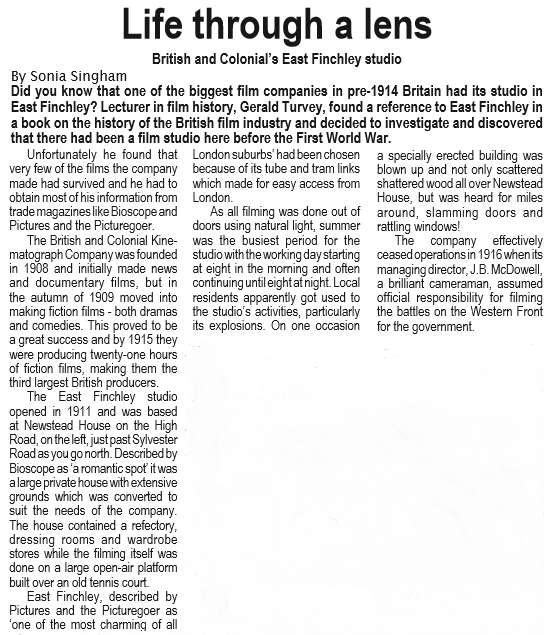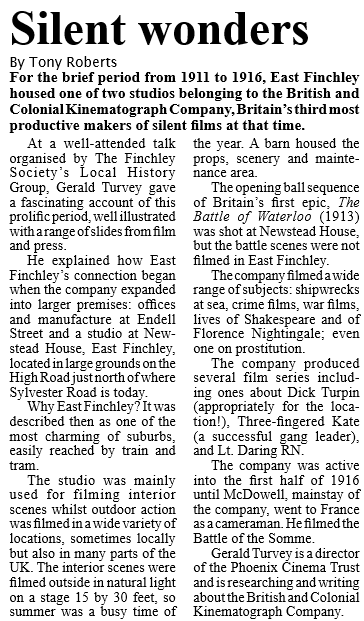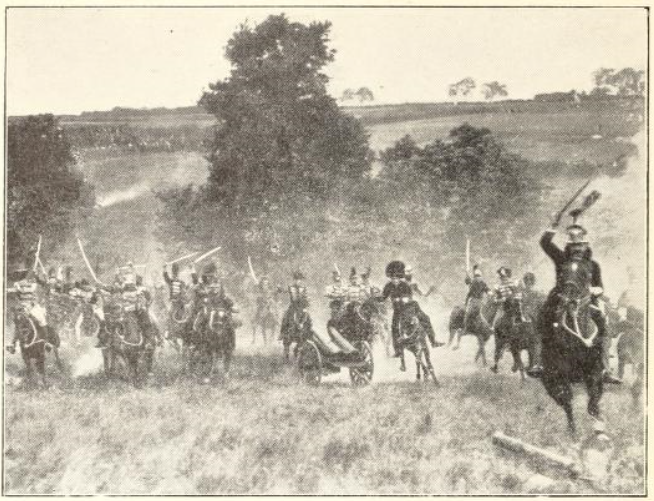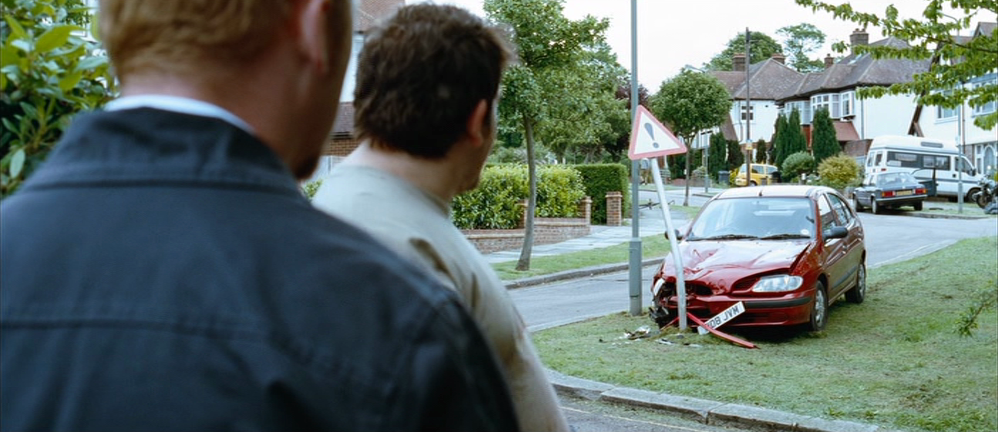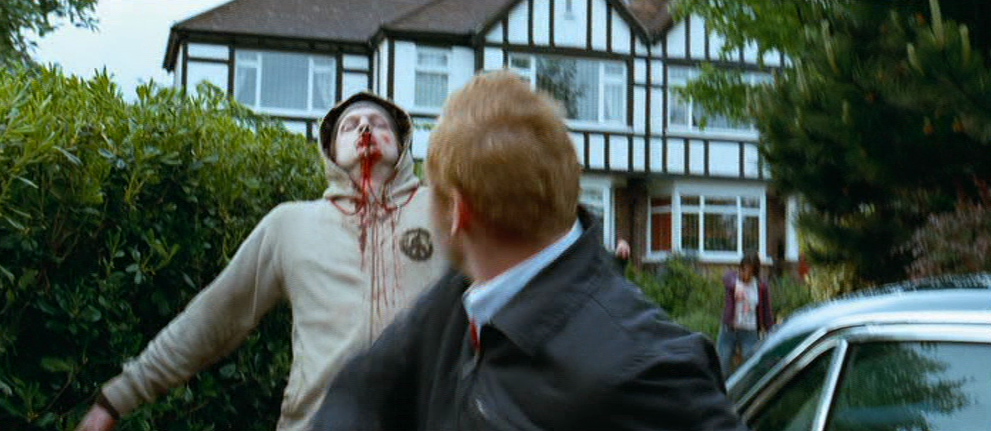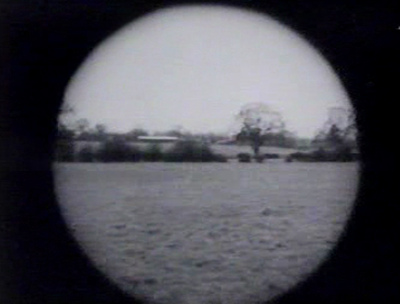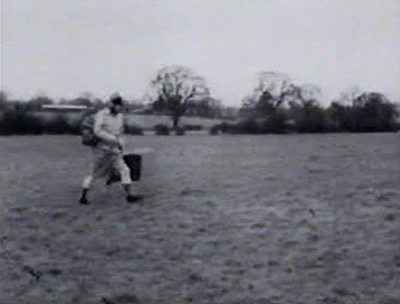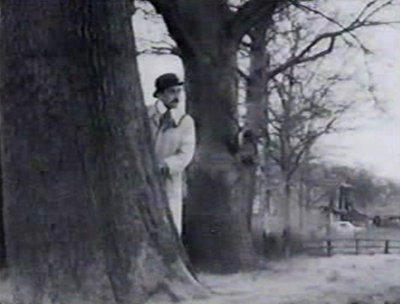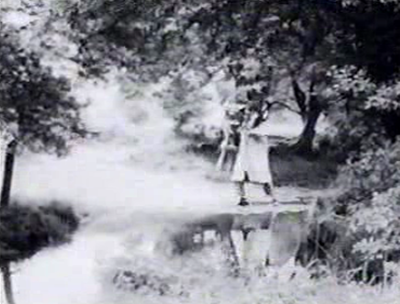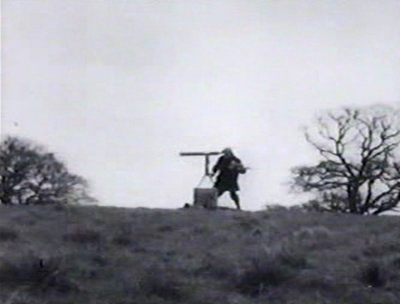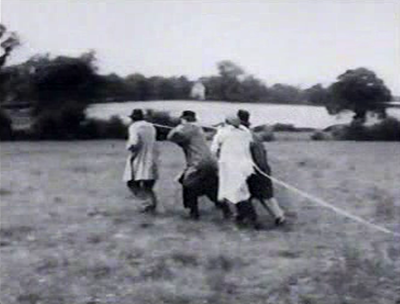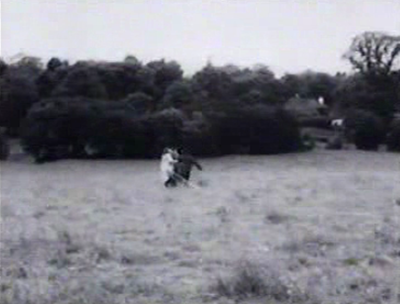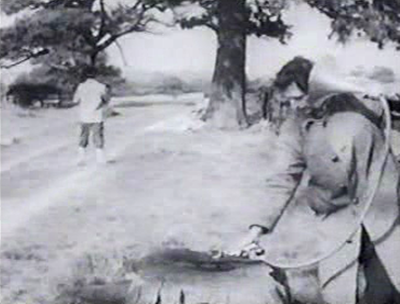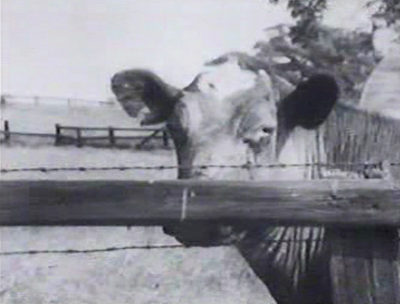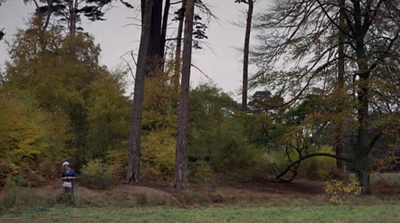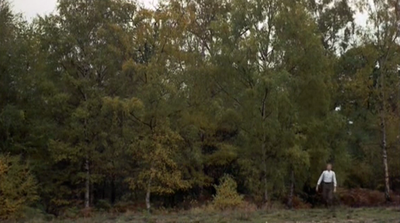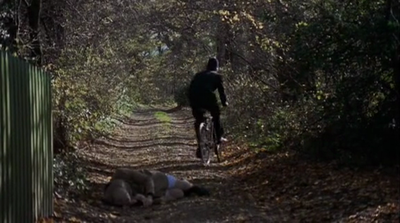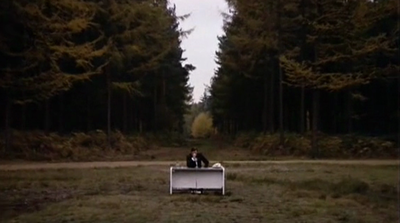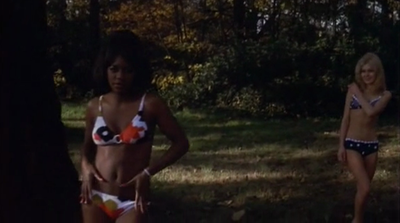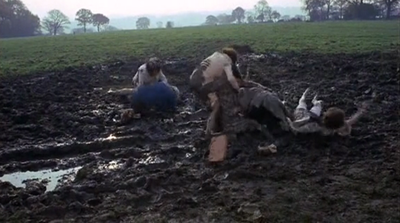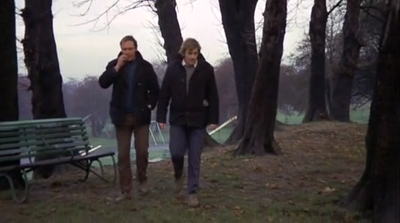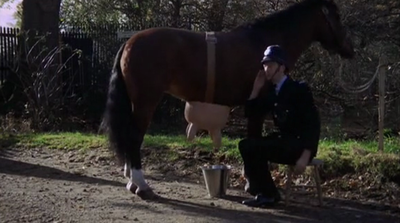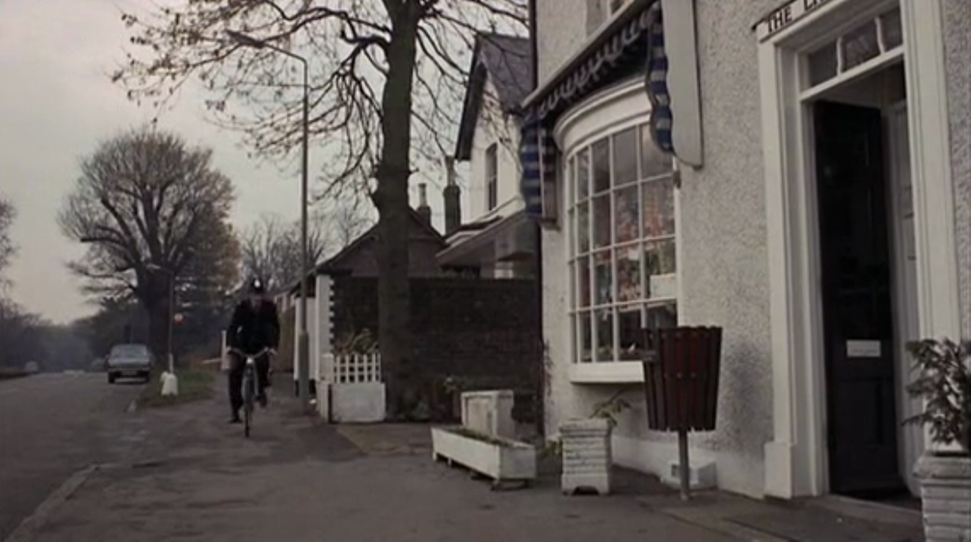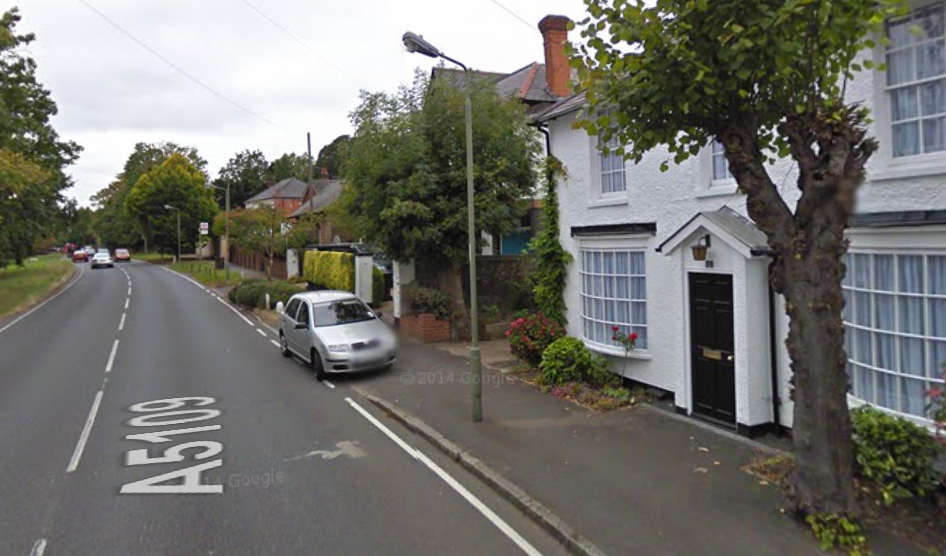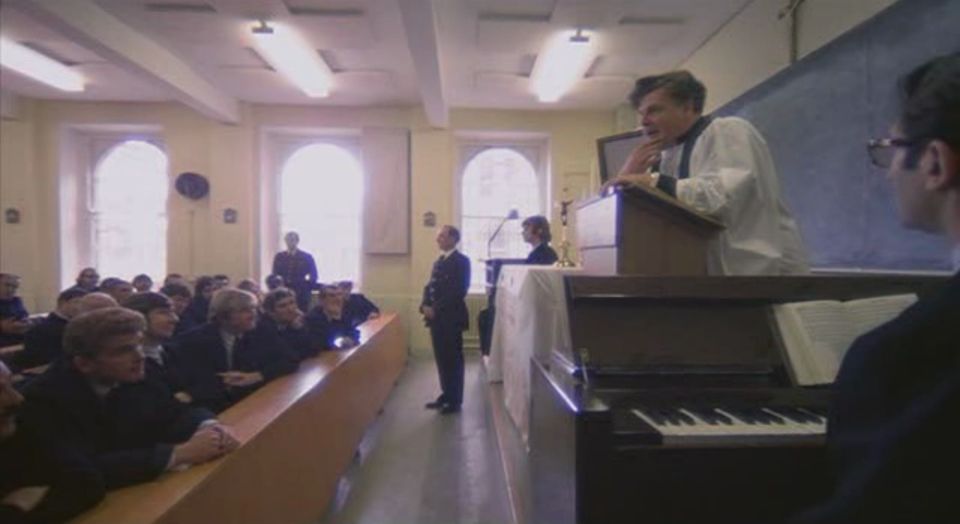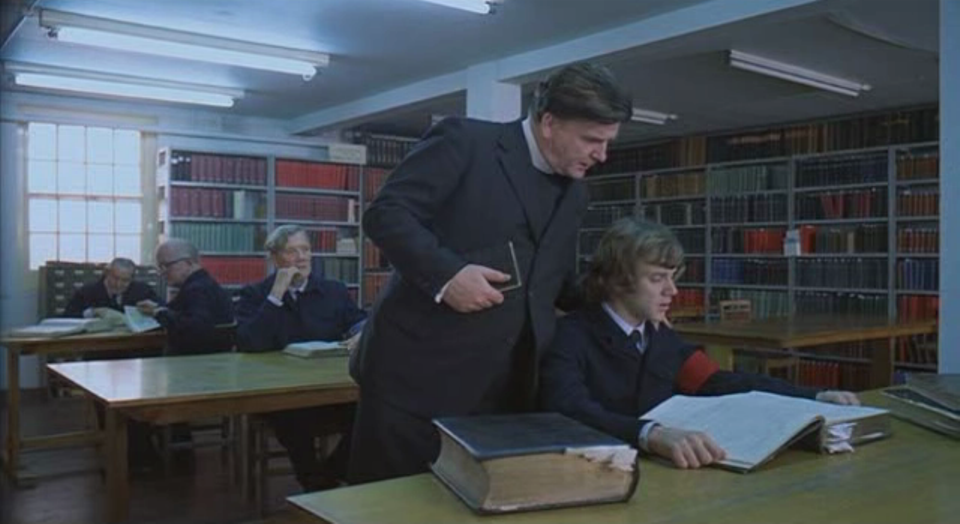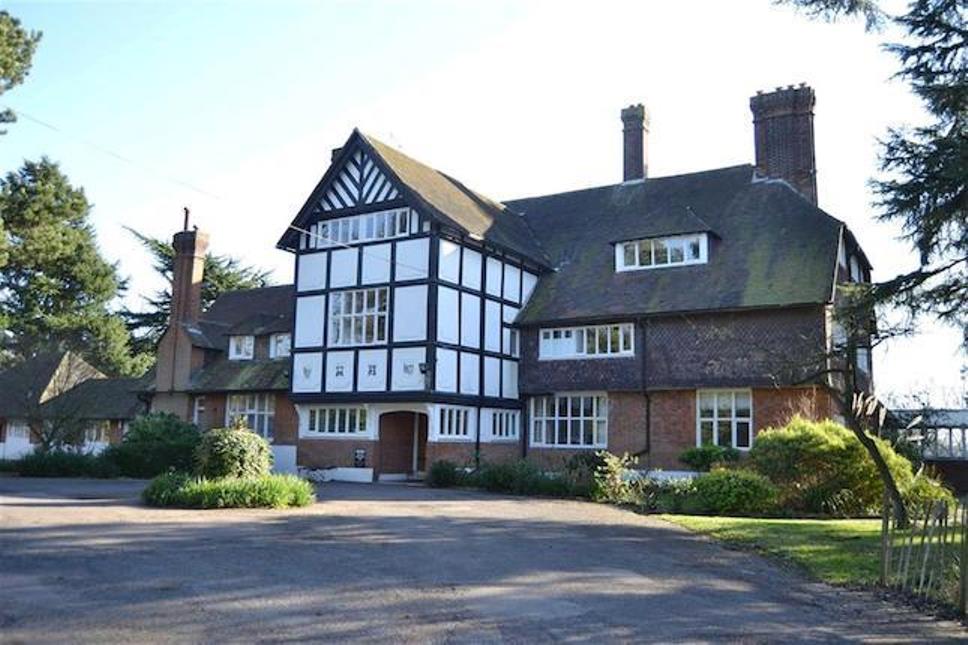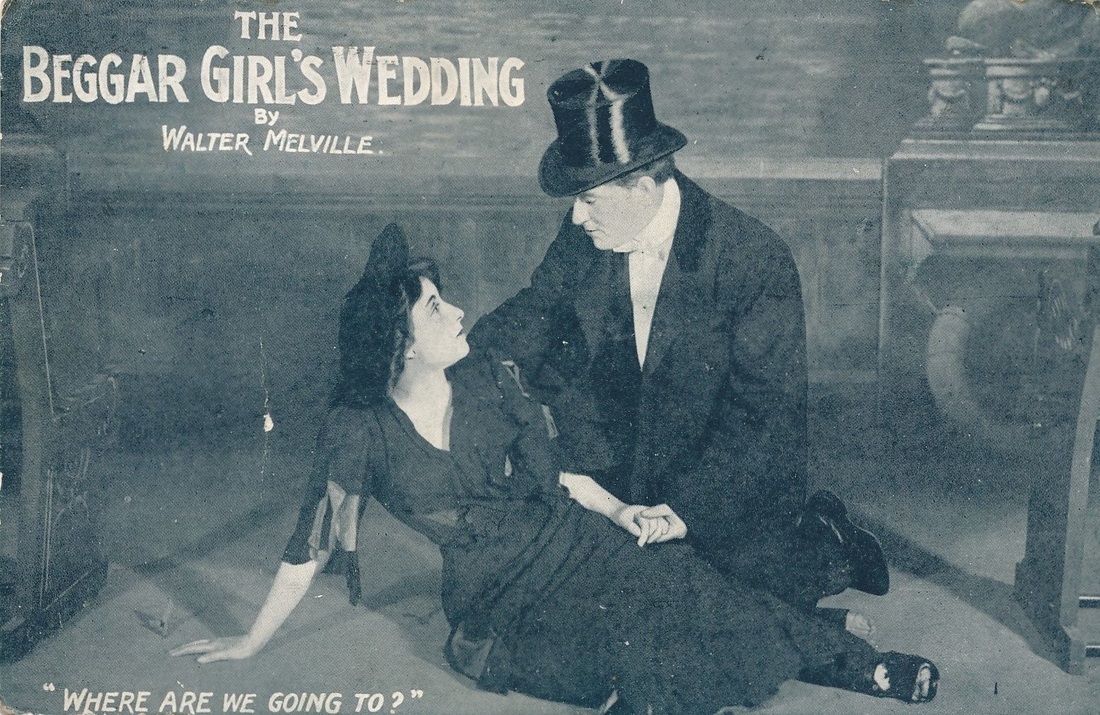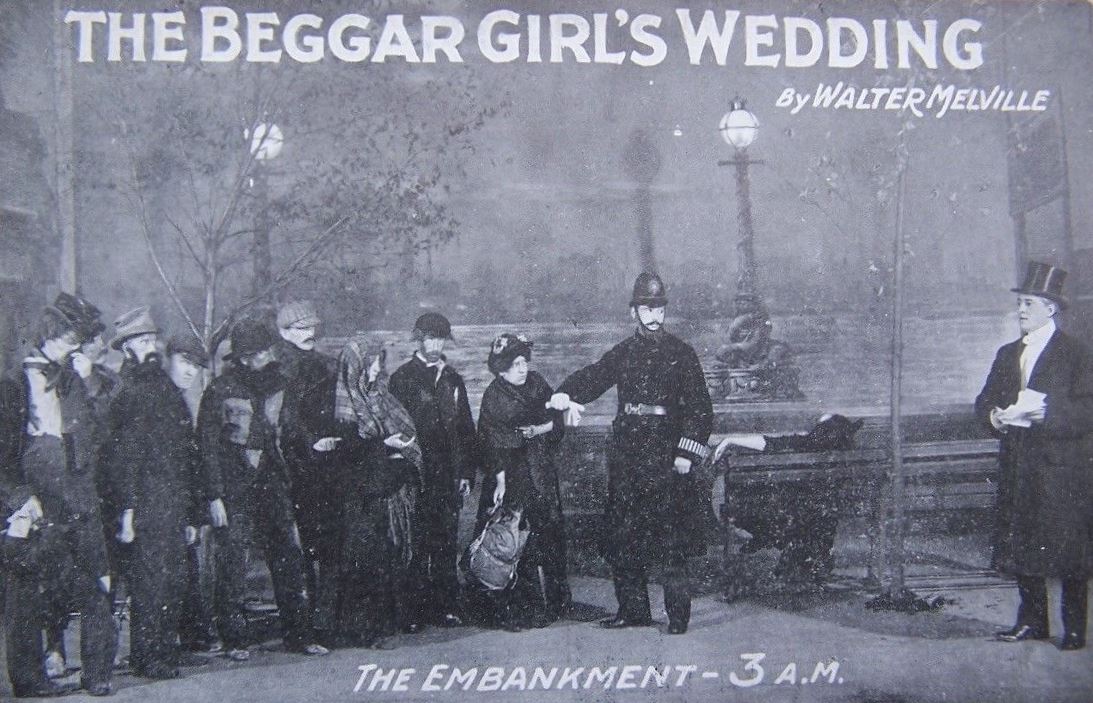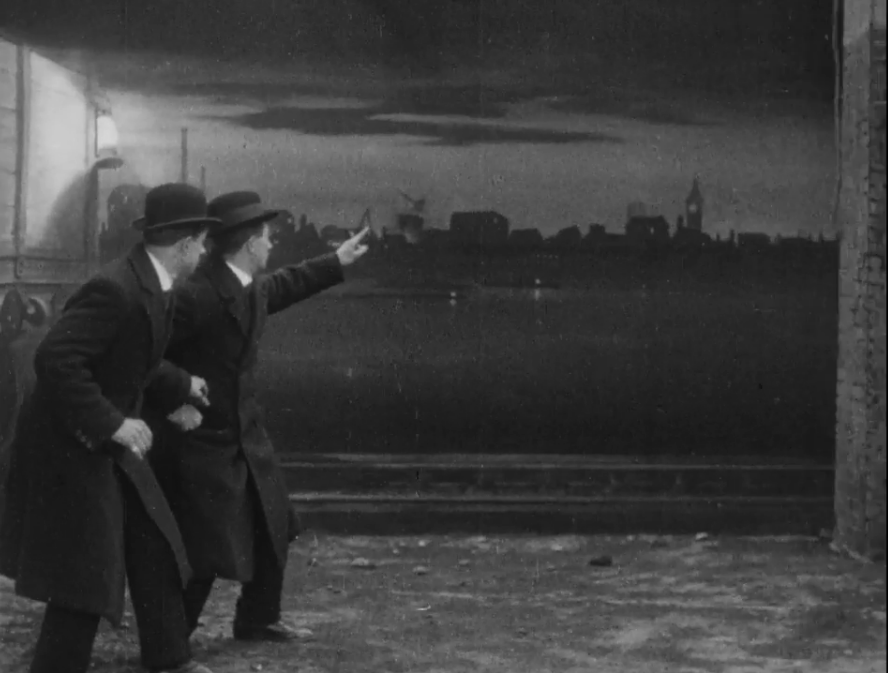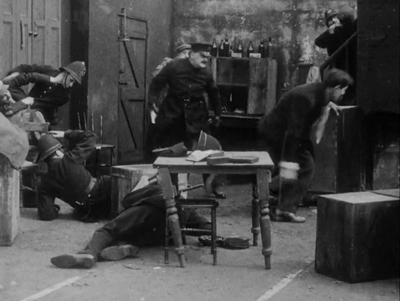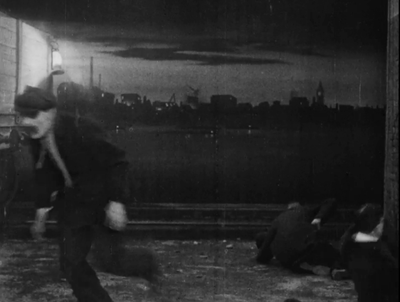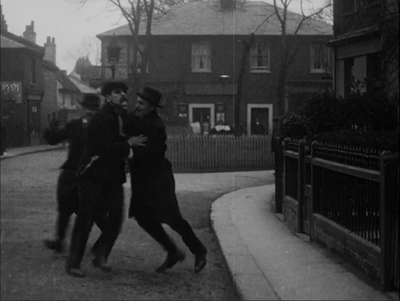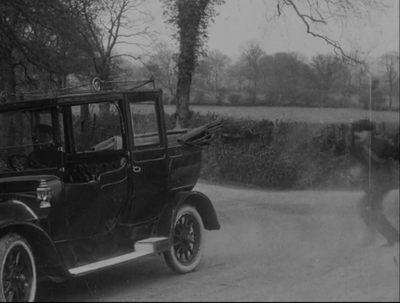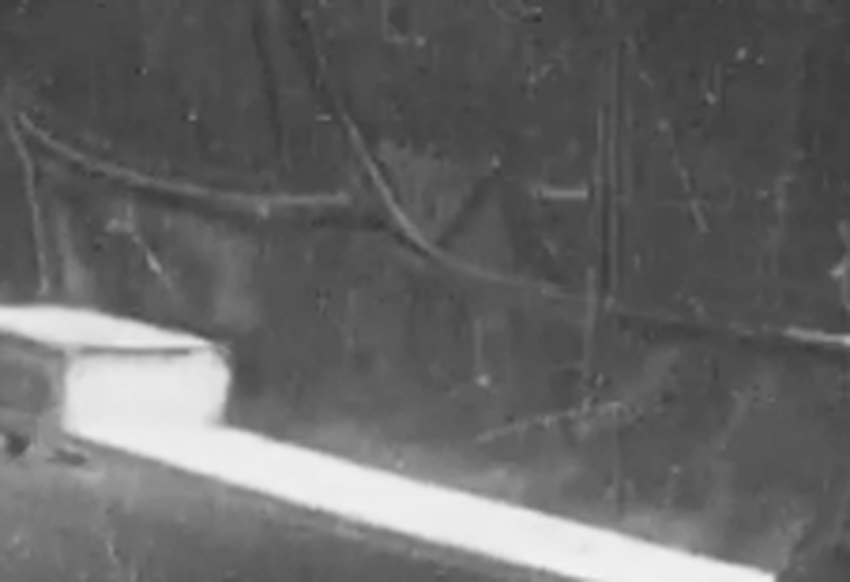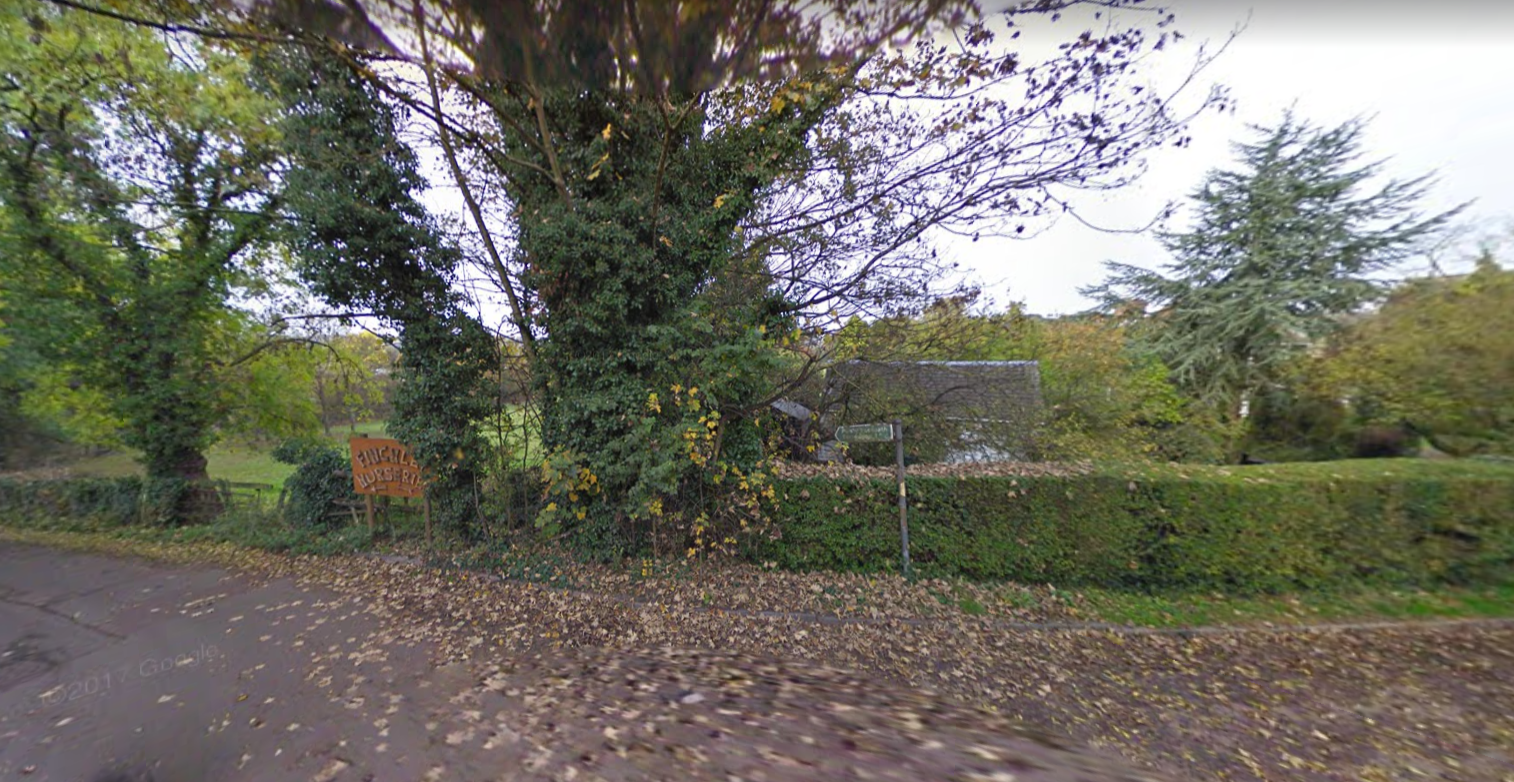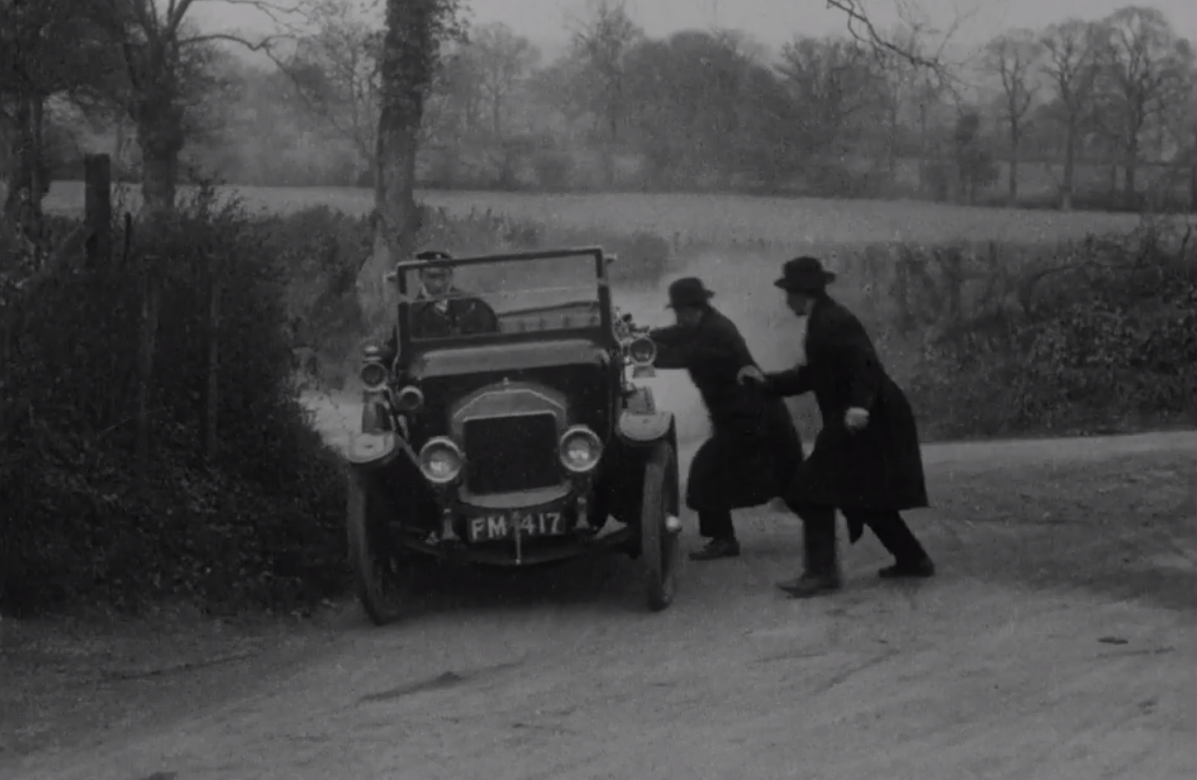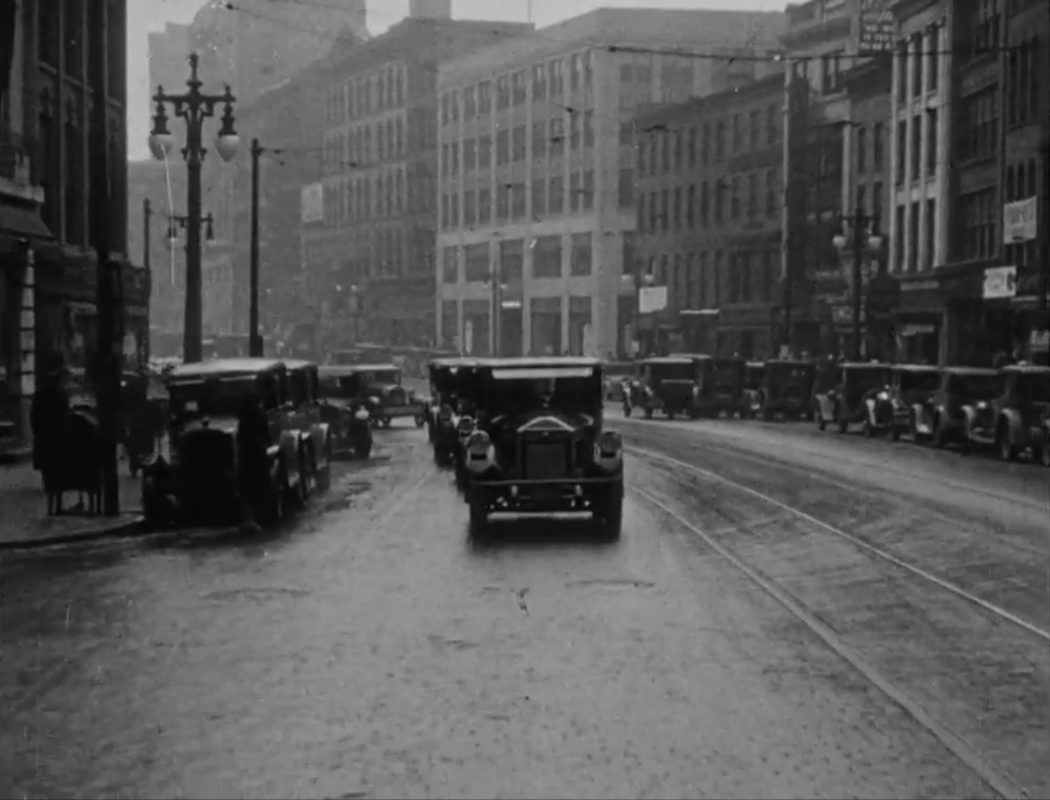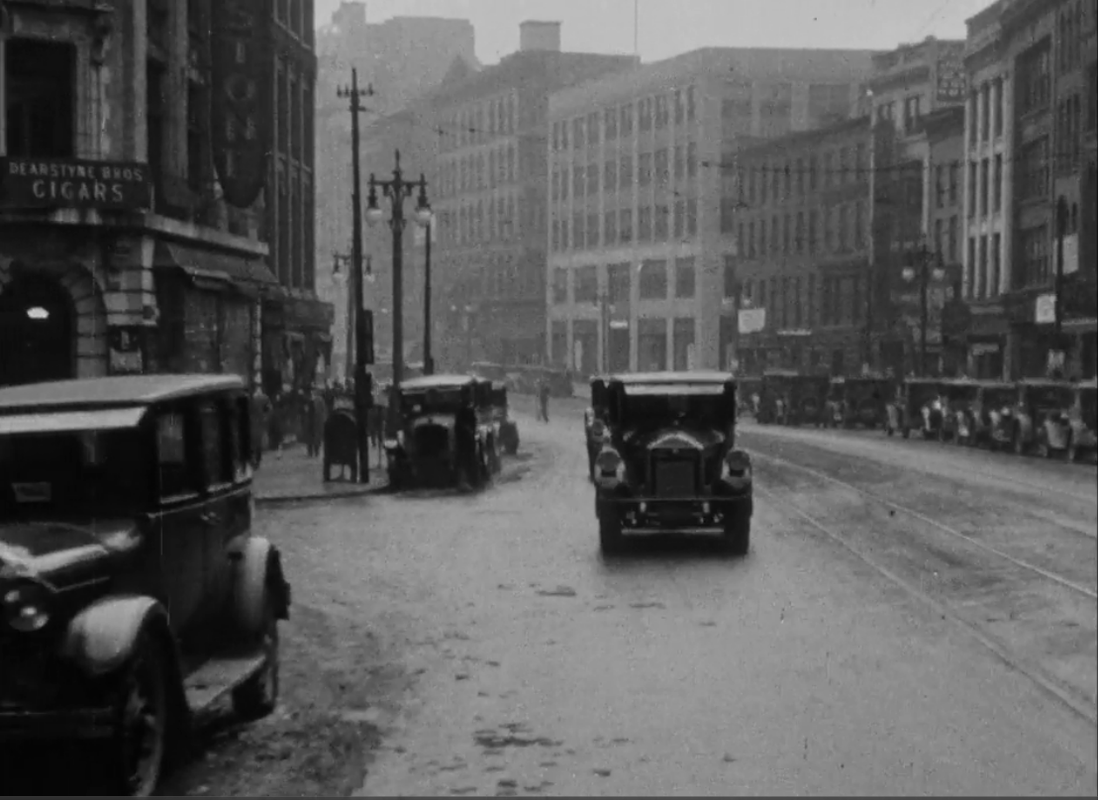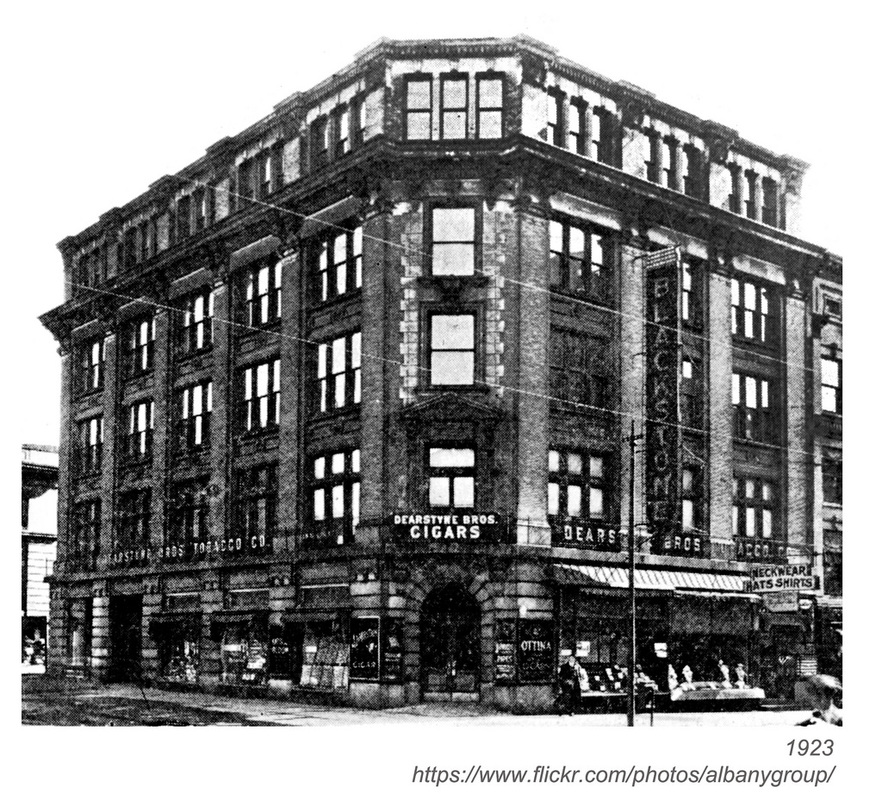straight out of Whetstone:
suburban filmmaking in North London c.1916
suburban filmmaking in North London c.1916
This telegram, sent to her father by a woman who has just married his personal secretary, is the only explicit indication of place in what remains of The Man With the Glass Eye (1916 - watch it here). Her fall from grace is a fall from the comforts of Hampstead to the miseries of Mean Street. It is also a movement across London, from northern to southern suburb. The social difference is expressed in contrasted domestic interiors:
The contrast in decor is striking, but the difference is even more dramatic in the staging. In both sets the rear door is used to deepen the space, but the short distance from front to back in the second emphasises the straightened circumstances of the young couple. The clutter in the first set invites focalisation on its objects, emphasising its visual richness:
The pictures on the wall in the Mean Street home look like they might reflect that impoverished milieu. All three look vaguely familiar, but I can't recognise any of them:
There are only three other interiors in the extant film - another room in the father's house, a church and the criminal's lair, 'the haunt of the Night Rat':
There are more than twice as many exteriors in the film. It is the localisation of these, unsurprisingly, that really interests me in this post.
My first thought was that the telegram could provide clues to the whereabouts of these locations. '14 Mean Street' is an invented address, referencing Arthur Morrison's 1894 book Tales of Mean Street, but the telegram was handed in at one real place, Shepperton-on-Thames, and received at another, Hampstead:
Neither of these, however, turns out to have been a location for The Man With the Glass Eye.
Incidentally, both Hampstead and Shepperton had already featured in London-made cinema. The location of the 1896 Lumière film 'Cyclists and riders arriving at the cottage', shot by Charles Moisson and featuring Félicien Trewey, is identified in the Lumière catalogue as Hampstead:
(I am still trying to identify which street in or near Hampstead this is. All suggestions gratefully received, here.)
Shepperton would not be home to its famous studios until 1931, but productions based at nearby Walton-on-Thames had by 1908 already ventured over in search of locations. Here is Shepperton's St Nicholas church in the Hepworth company's The Dog Outwits the Kidnapper:
Churches are among the easiest locations to trace; almost all have been photographed and most are still extant. The church in The Man With the Glass Eye is only shown from one angle but there is enough to enable identification:
Identification is even easier if the church is recognised as the one seen in the 1970 Hammer production Taste the Blood of Dracula:
This, as Derek Pykett's British Horror Film Locations tells us (2008, p.114), is St Andrew's Church, Totteridge:
It makes sense that the makers of The Man With the Glass Eye used Totteridge as a location. The production company was British Empire Films, based in neighbouring Whetstone. The practice of finding locations in the vicinity of the studio is very common, and not only in early cinema: Taste the Blood of Dracula was made at Borehamwood, about five miles from Totteridge. The British Empire Film studios were about two miles away, in the grounds of a house called Woodlands, just off the Great North Road:
In his book Finchley and Whetstone Past, with Totteridge and Friern Barnet, John Heathfield gives a history of the site and the studios, with interesting detail about the filmmakers' interaction with the local community:
The film that Jack Prime remembers playing a minor part in must have been The Girl Who Took the Wrong Turning. Here, in a photograph of the 1911 stage production on which it was based, is the returning sailor:
These articles don't mention filming in adjoining districts, a practice evident from The Man With the Glass Eye. There are at least five more locations in the Totteridge area. The post office where the telegram is handed in - supposedly Shepperton - is in Totteridge village:
A letter is posted on Barnet Lane:
Another letter is posted on Totteridge Lane:
The police chase the villain up Totteridge Common from Highwood Hill:
Having rid himself of his pursuers, the villain arrives at this house:
This is Terenure, at 121 Totteridge Lane, now demolished. The photograph below left was taken in 1998. The photograph below right, taken yesterday, is of the house that replaced the one in the film:
A view from its front door shows a neighbouring house, also now demolished, I think:
Two other houses remain to be identified. Not every house in Totteridge is visible on Google Street View, and many are invisible to the naked eye, hidden behind high walls and greenery, like this one:
The other unidentified house may not be in Totteridge. I have seen no photographs of the studio buildings, but I wouldn't be surprised if this turned out to be Woodlands itself, in the grounds at Whetstone:
There are, then, six locations that are definitely in Totteridge. One location in the film is definitely somewhere else. An early sequence shows a street with shops and cheap housing, a different kind of place altogether:
This is Market Place, East Finchley, N.2:
The area is now completely transformed after WW2 bomb damage:
To get to Market Place the filmmakers would have headed south from the Whetstone studios, in red on the map below, straight down the Great North Road for three miles:
On the way they may have crossed the path of filmmakers from the British and Colonial Kinematograph Company, based at Newstead House (in blue on the map) - that is if the B&C company hadn't already departed for Walthamstow or the War. Here are two items on that company from The Archer, East Finchley's local interest paper:
The British and Colonial was famous for shooting in faraway locations such as Newfoundland and Jamaica (see here), but I couldn't say for sure whether its local filmmaking extended beyond the confines of Newstead House and grounds. The few stills I have seen from B&C films suggest possible excursions into the nearby countryside (possibly Totteridge?):
But I haven't seen anything to suggest that British and Colonial films might, like those of their Whetstone neighbours, have documented the streets of East Finchley.
That brief glimpse of Market Place in The Man With the Glass Eye is, I think, East Finchley's only big-screen appearance until Abbots Gardens featured in the 2004 film Shaun of the Dead:
Despite its suitably large houses and attractive environs, and despite the proximity of the Elstree Studios, Totteridge has barely fared better. In 1959 Peter Sellers, Spike Milligan and friends made a short comic film in and around Totteridge Lane:
Twelve years after The Running, Jumping and Standing Still Film, the Monty Python team filmed some of And Now For Something Completely Different in Totteridge. I'm guessing this was largely the scenes in fields and woodland:
The production used the A1 Dairy buildings on Whetstone High Road as a studio, which explains why they used Totteridge locations. Most of the film's exteriors were shot on the streets of North Finchley, but the exterior of the tobacconist's shop is certainly in Totteridge Village:
That same year interiors at St Edward's School, Totteridge Common, were used in A Clockwork Orange:
And that's about it for Totteridge in films. When I was looking for locations last week a local gardener told me there had been filmmaking going on a few weeks before at Ellern Mede, Norman Shaw's Grade II-listed Tudor Revival house from 1876 (now unoccupied):
I'd be interested to learn what film was being made here in 2016, if anyone knows.
The actual topography of The Man With the Glass Eye, passing from East Finchley to Totteridge, doesn't match the narrative topography presented on the telegram, passing from Hampstead to South West London, but the differences between places in each case do correspond to similar social differences. At Whetstone the British Empire Film Company had within its reach the varied types of place necessary to stage dramas of social distinction: urban and rural, proletarian and bourgeois, sordid and elegant, etc. The article in Pictures and the Picturegoer that I have already quoted indicates that melodramas of this type were typical of the company's production, and affirms that for certain films they went beyond the vicinity of Whetstone for their locations. For The Girl of my Heart they filmed at Waterloo and Vauxhall stations, for The Girl Who Took the Wrong Turning they filmed at Leicester Square, and for The Beggar Girl's Wedding they filmed on the Embankment. These are all films based on well-known stage productions, and without having seen the films we can imagine that the use of real locations rather than theatrical backdrops successfully affirmed the advantages of cinema over theatre. Here is how the 1908 theatrical production staged the Embankment scenes in The Beggar Girl's Wedding:
Though The Man With the Glass Eye was almost certainly based on a play, there seems to be no information available about that source or its author. The director of the film is also unknown, though I would guess it was either Leedham Bantock or Albert Ward, to whom are attributed other B.E.F. melodramas from the same period.
Discounting the anomalous appendage at the end of the available print (see Appendix below), there is one other place in The Man With the Glass Eye:
Discounting the anomalous appendage at the end of the available print (see Appendix below), there is one other place in The Man With the Glass Eye:
This is some kind of railway siding beside a wide river. The backdrop depicts, across the river, a collection of industrial buildings and, somewhat incongruously, a Big Ben-type clock tower. This scene was not, then, one of the exceptions where it was 'found advantageous' to film in a real place. Coming near the very beginning of the film, after the first scene where the villain's haunt is raided by the police, also studio-made, it sets up an expectation of quasi-theatrical staging that the immediately following scenes happily undo. The policemen's pursuit of the Night Rat cuts on the action to take us from constructed spaces to real places, from the studio in Whetstone to Market Place in East Finchley and then to a country lane in Totteridge:
I don't know exactly where in Totteridge is the junction in the last image above, and don't hold out much hope of it being recognisable now, but there is one clue to pursue. Reflected in the door of the awaiting car is a cottage of some sort. Here it is, magnified and flipped horizontally:
If I find it I'll let you know.
Update December 2018: Paul Winnett identifies this junction as Burtonhole Lane, and I am strongly inclined to agree:
Update December 2018: Paul Winnett identifies this junction as Burtonhole Lane, and I am strongly inclined to agree:
References
- The Man With the Glass Eye (1916), accessible via the BFI Player
- Derek Pykett, British Horror Film Locations (Jefferson North Carolina: McFarland, 2008)
- John Heathfield, Finchley and Whetstone Past, with Totteridge and Friern Barnet (London: Historical Publications Ltd, 2001)
- Pictures and the Picturegoer, accessible at Lantern: the media history digital library
- The Archer, East Finchley's community newspaper
- Ordnance Survey maps accessible at the National Library of Scotland: map images
I am grateful to the staff of the wonderful Barnet Museum for help with identifying Totteridge locations, to Mr Stavrianakis of Totteridge Lane, and to Tim Seago at St Andrew's Church, Totteridge.
Appendix
The fragment of The Man With the Glass Eye that the BFI has made available ends with an enigmatic shot of a car on city street:
Narratively this seems to have no connection with what has gone before. In the preceding sequence the police have discovered the private secretary standing over the body of his murdered father-in-law, and have concluded that he is the culprit. We might conclude that this is the police car taking the suspect to headquarters, but topographically the shot makes no sense. This is a street in Albany, New York:
Unless the plot has taken an unannounced and dramatic turn Stateside, we must conclude that this shot has been erroneously tagged on to the end of what remains of The Man With the Glass Eye.
